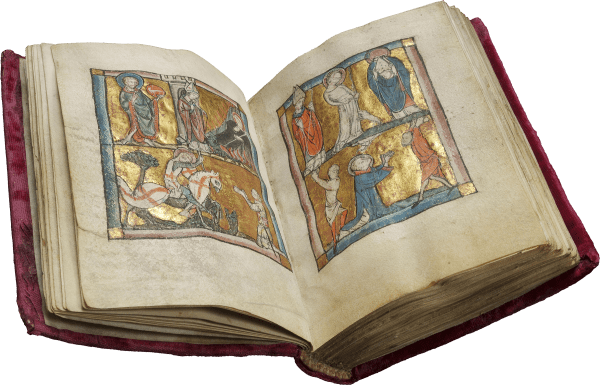


Hours of Jean Antoine de Mahieu and Jacqueline de Sivry (use of Mons)
, Southern Netherlands, Mons, c. 1460 (original portion), c. 1480-1490 (updated)




Hours of Jean Antoine de Mahieu and Jacqueline de Sivry (use of Mons)
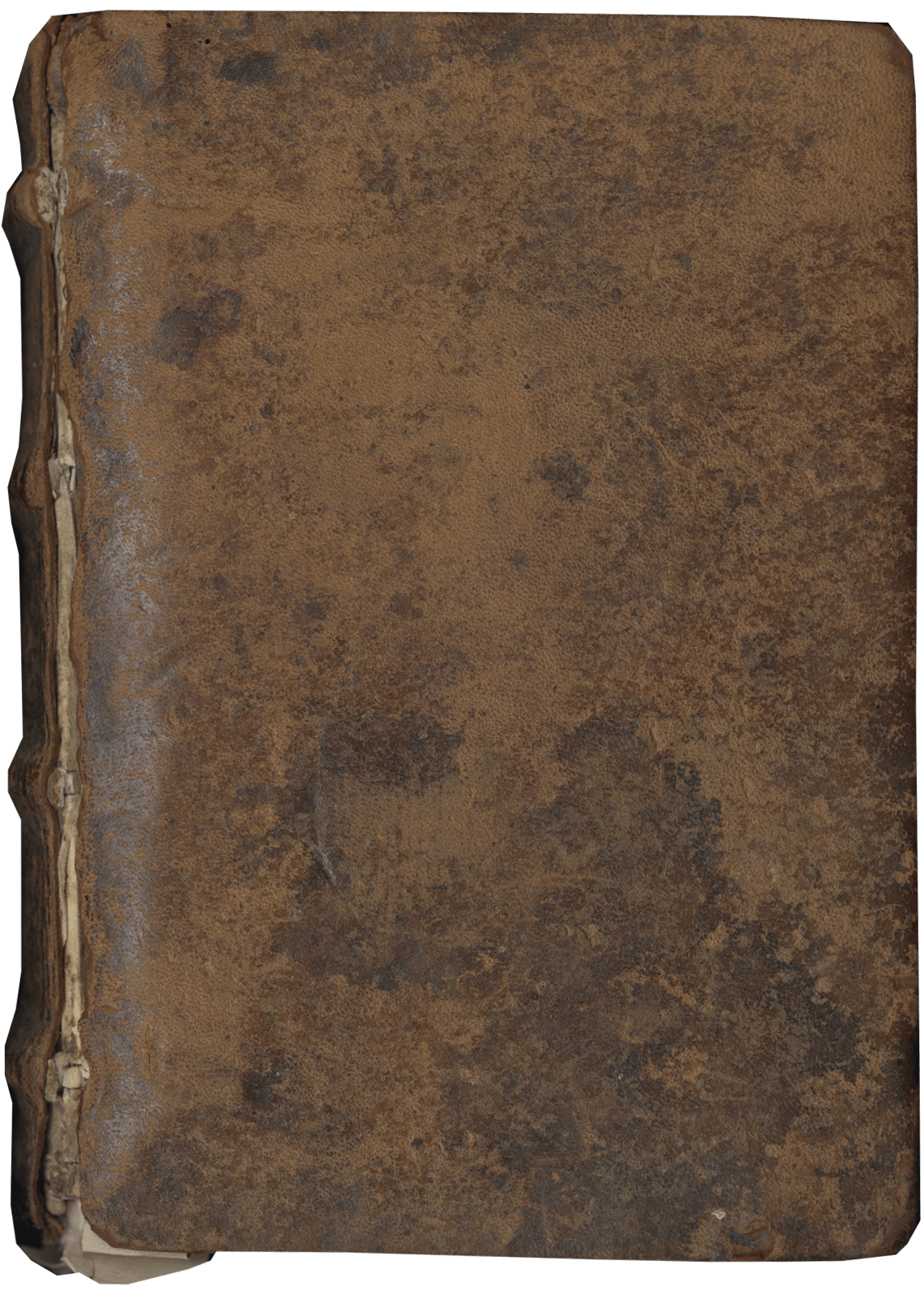


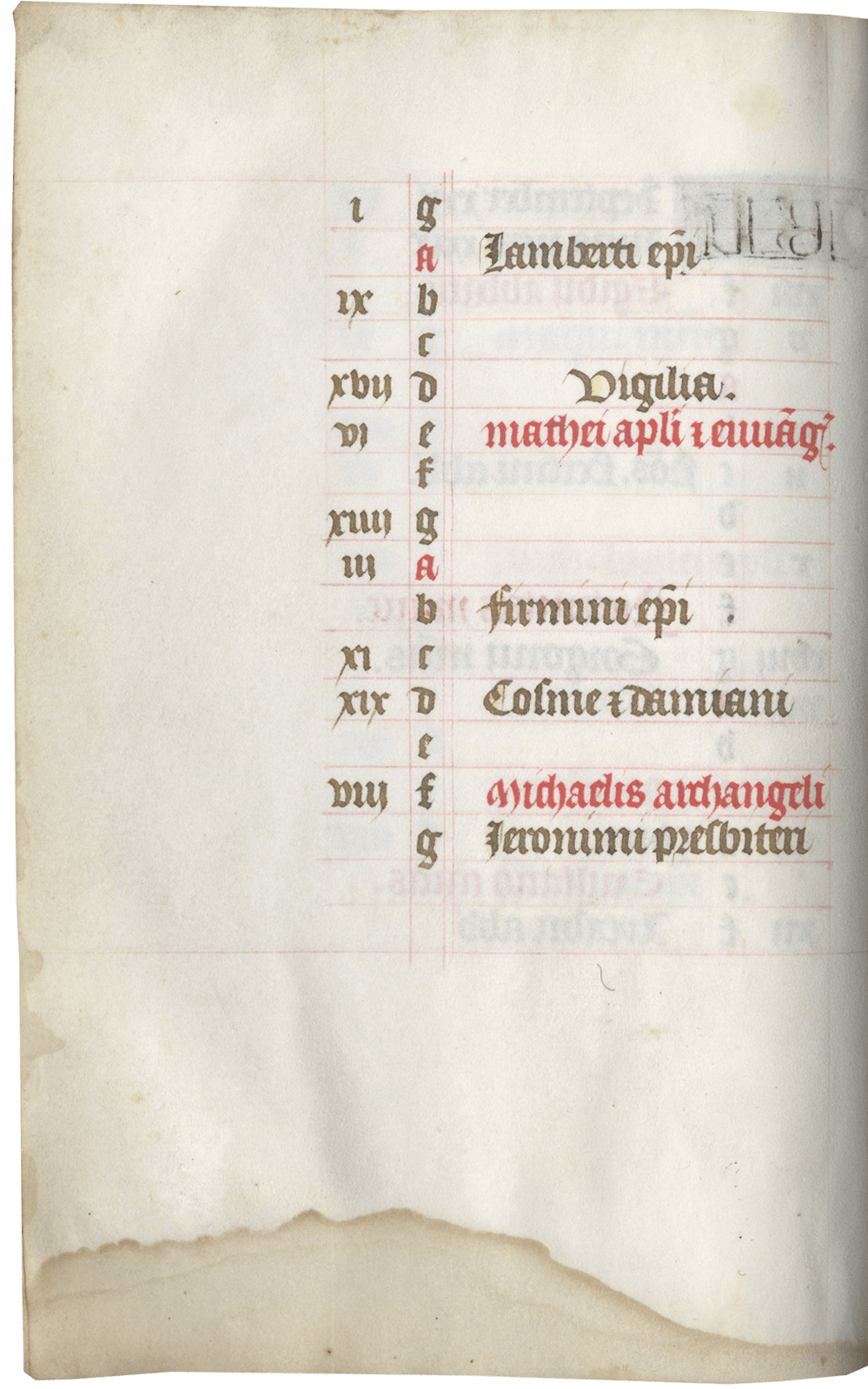

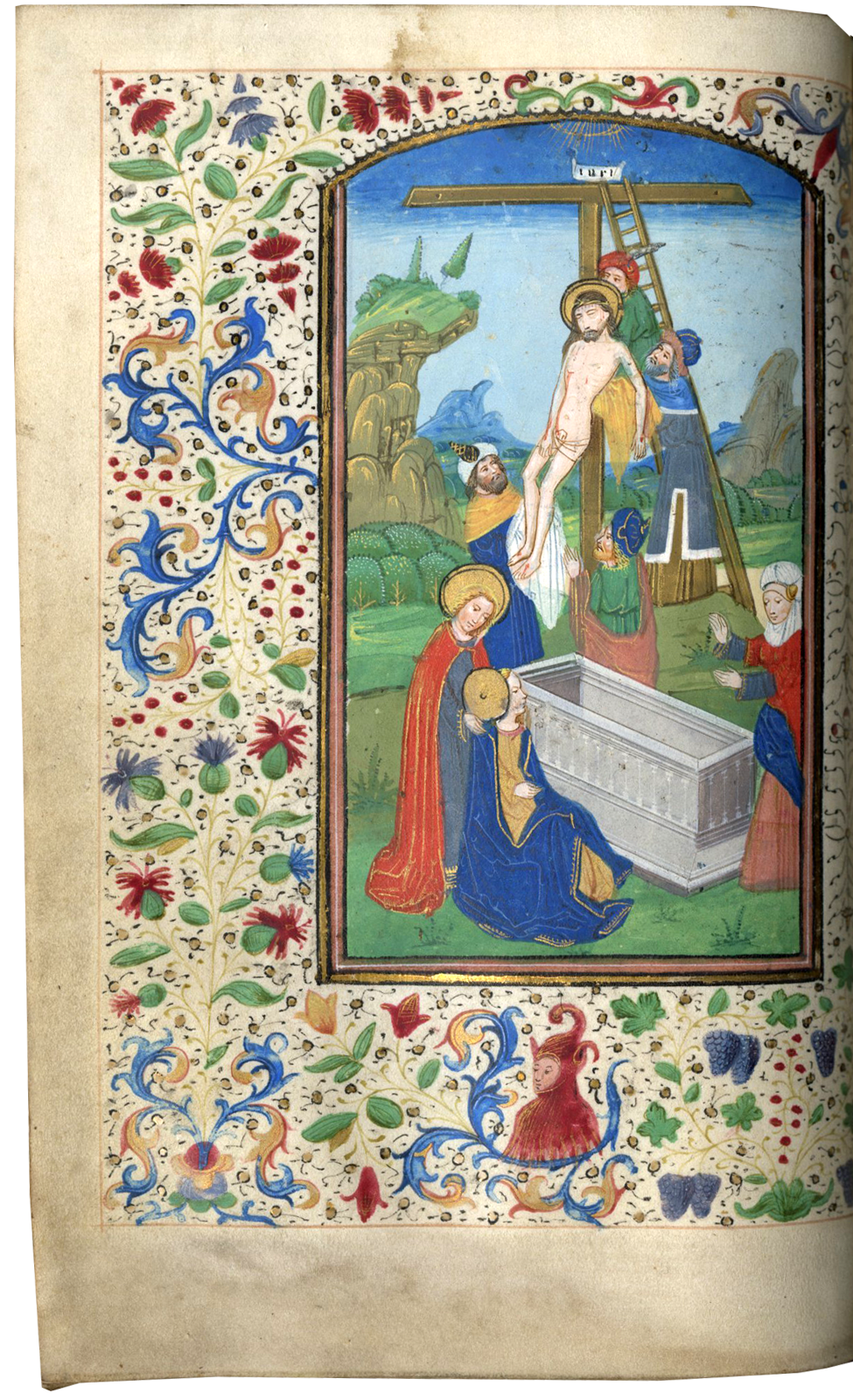

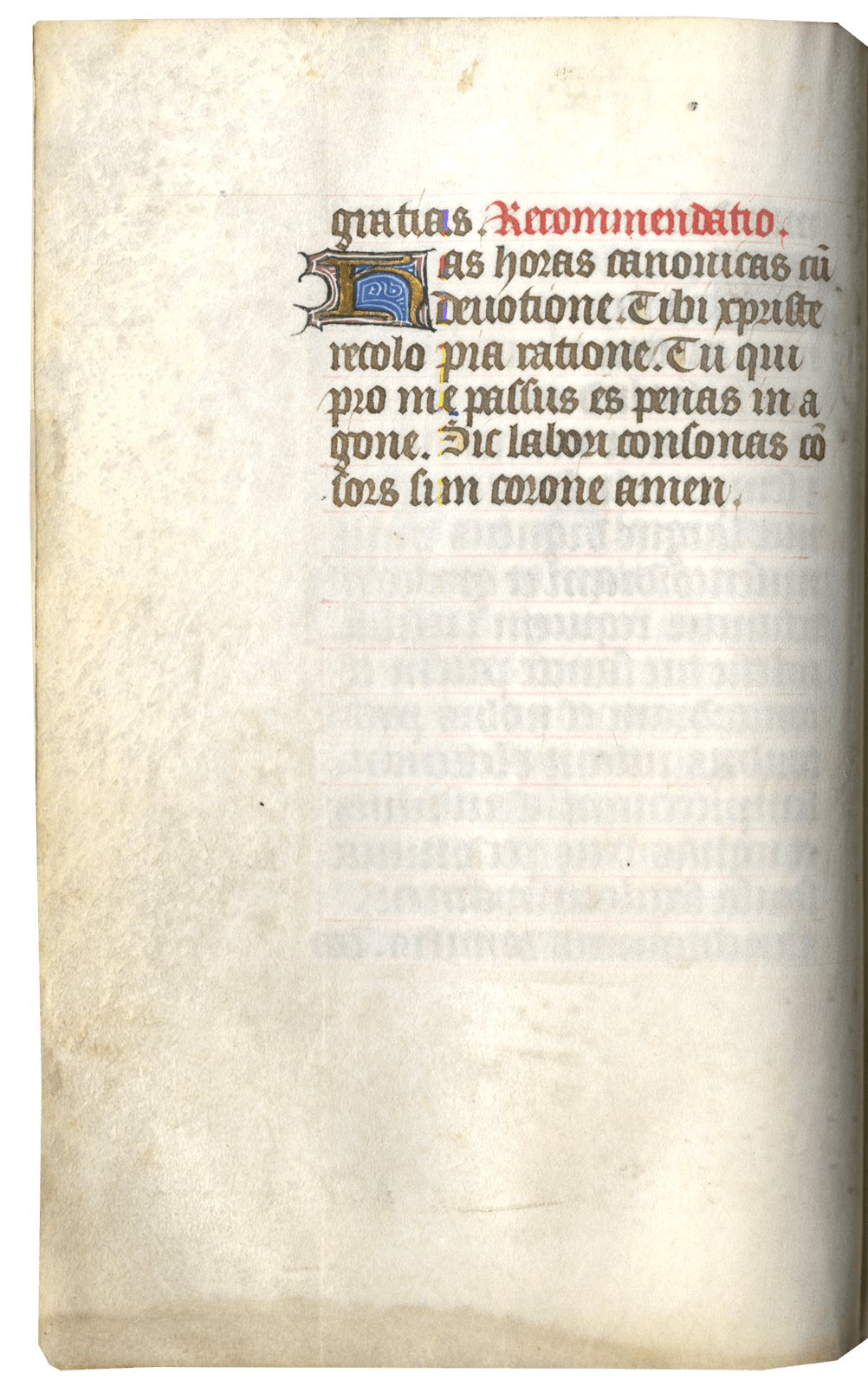
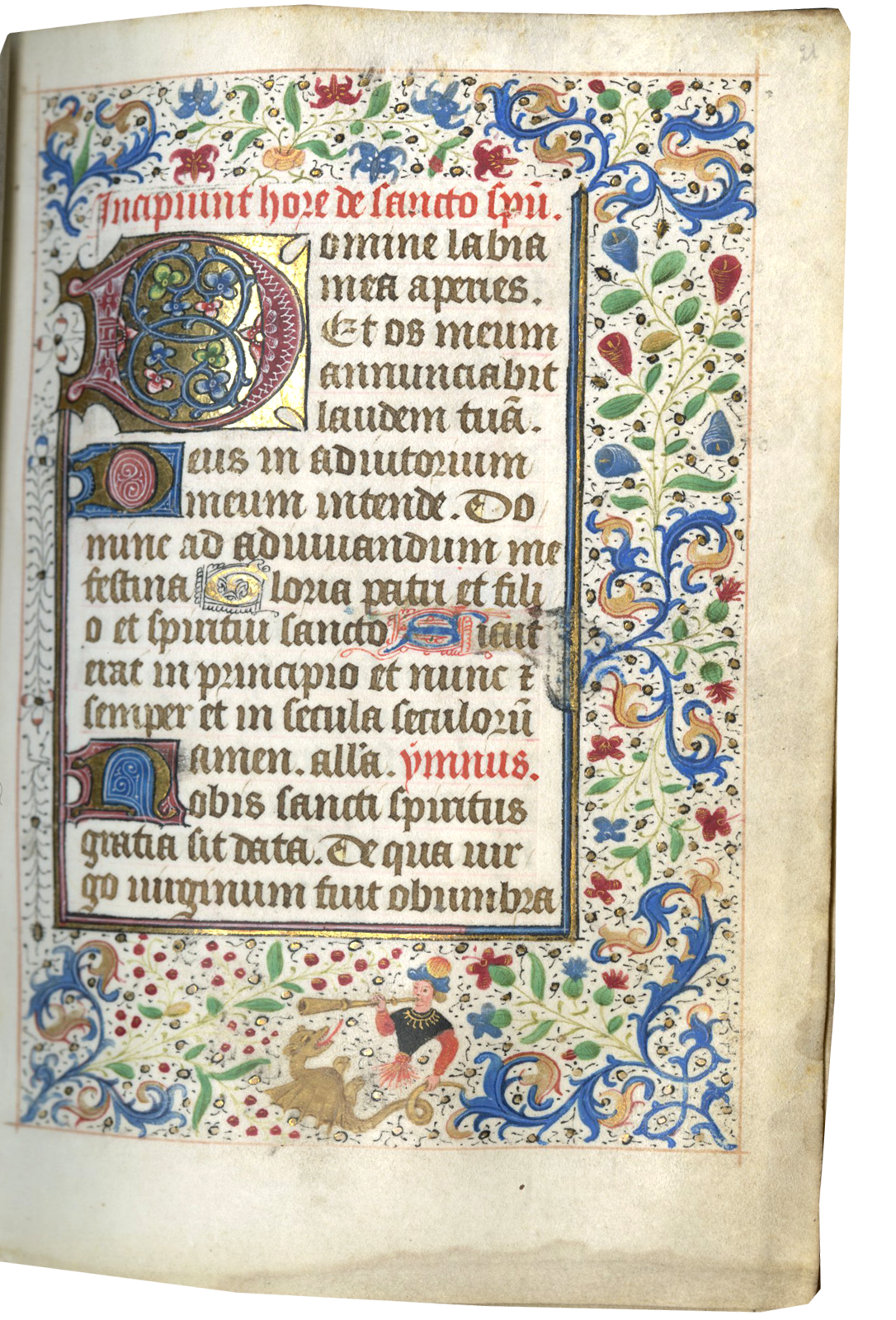
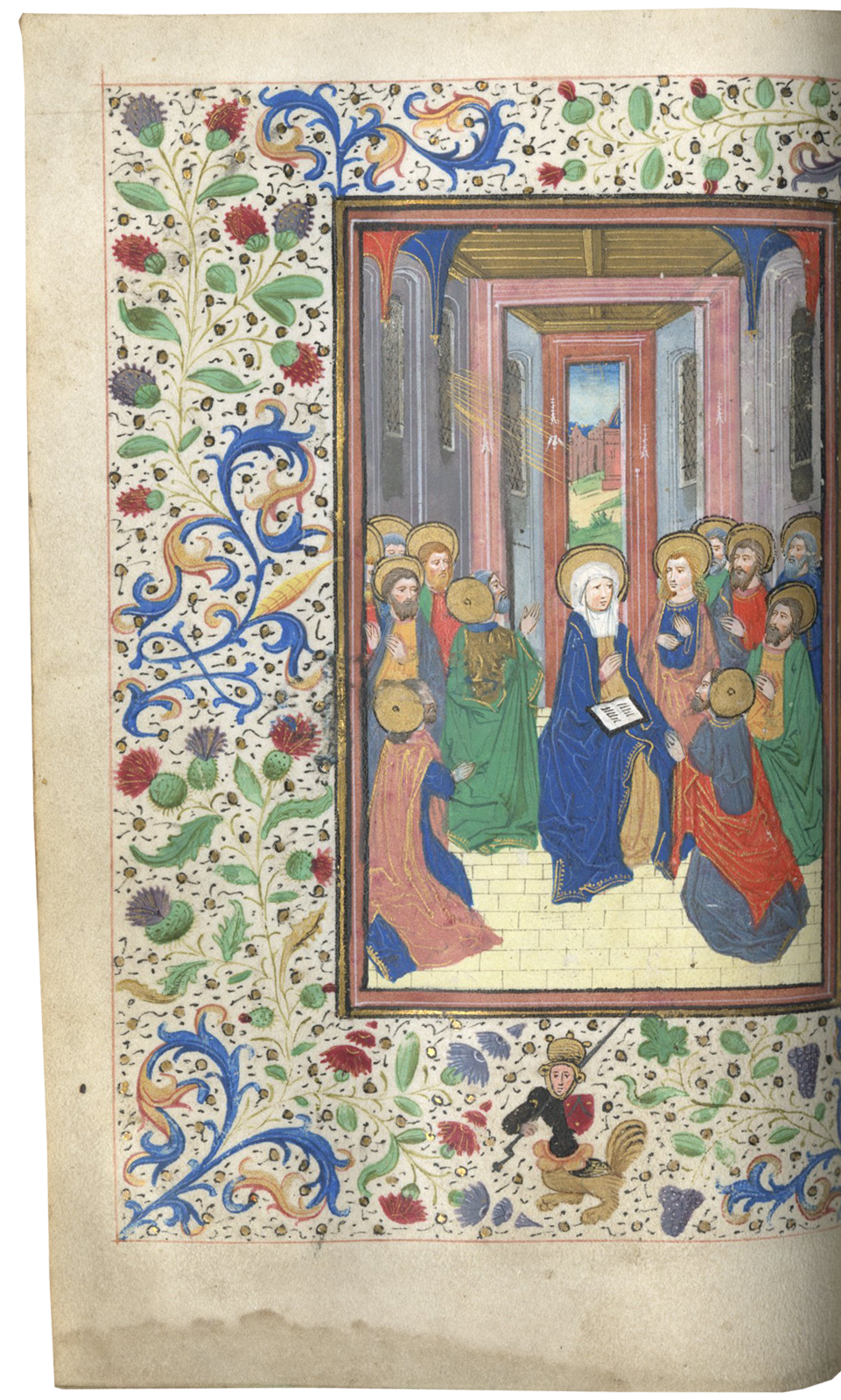
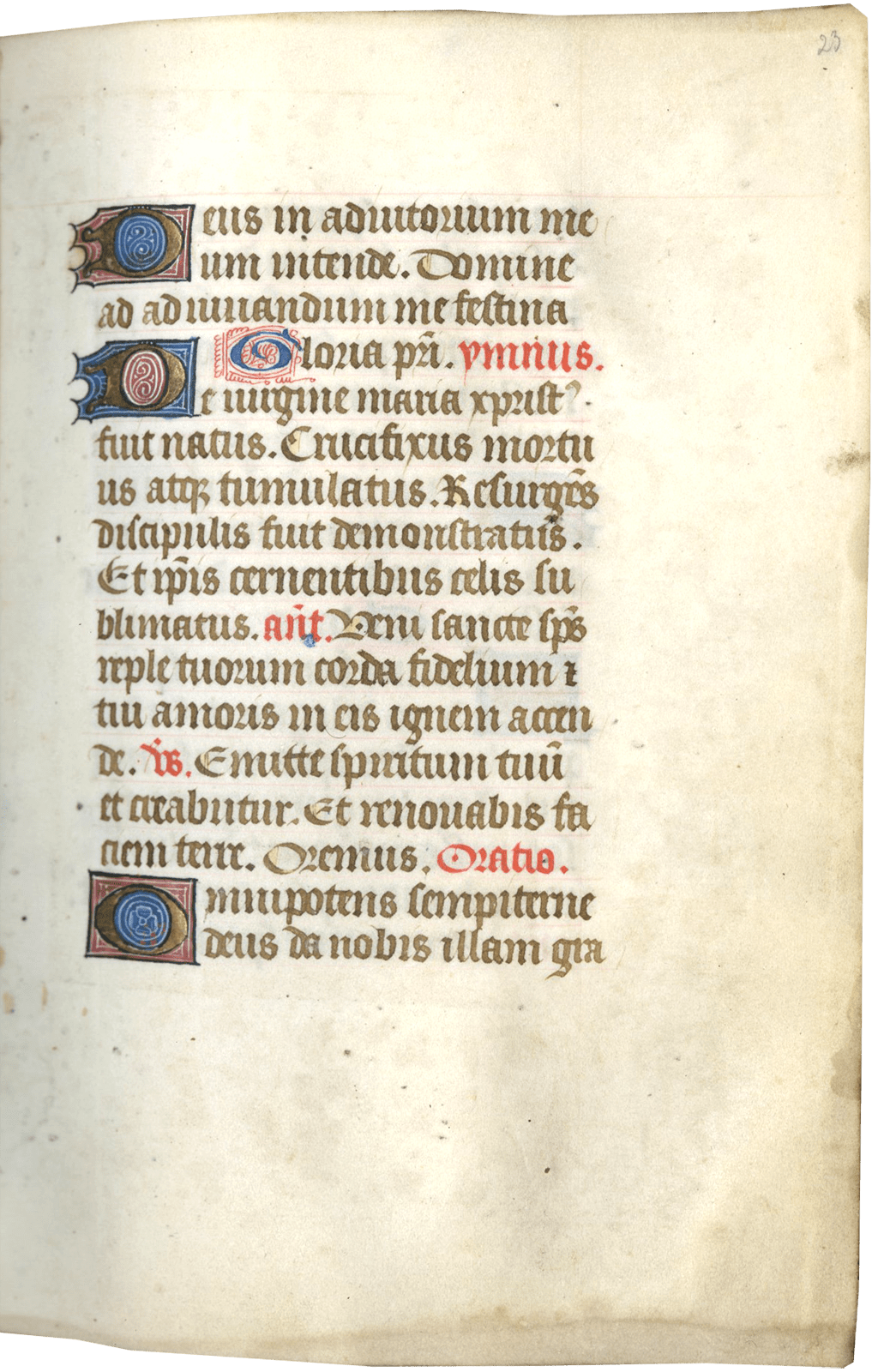
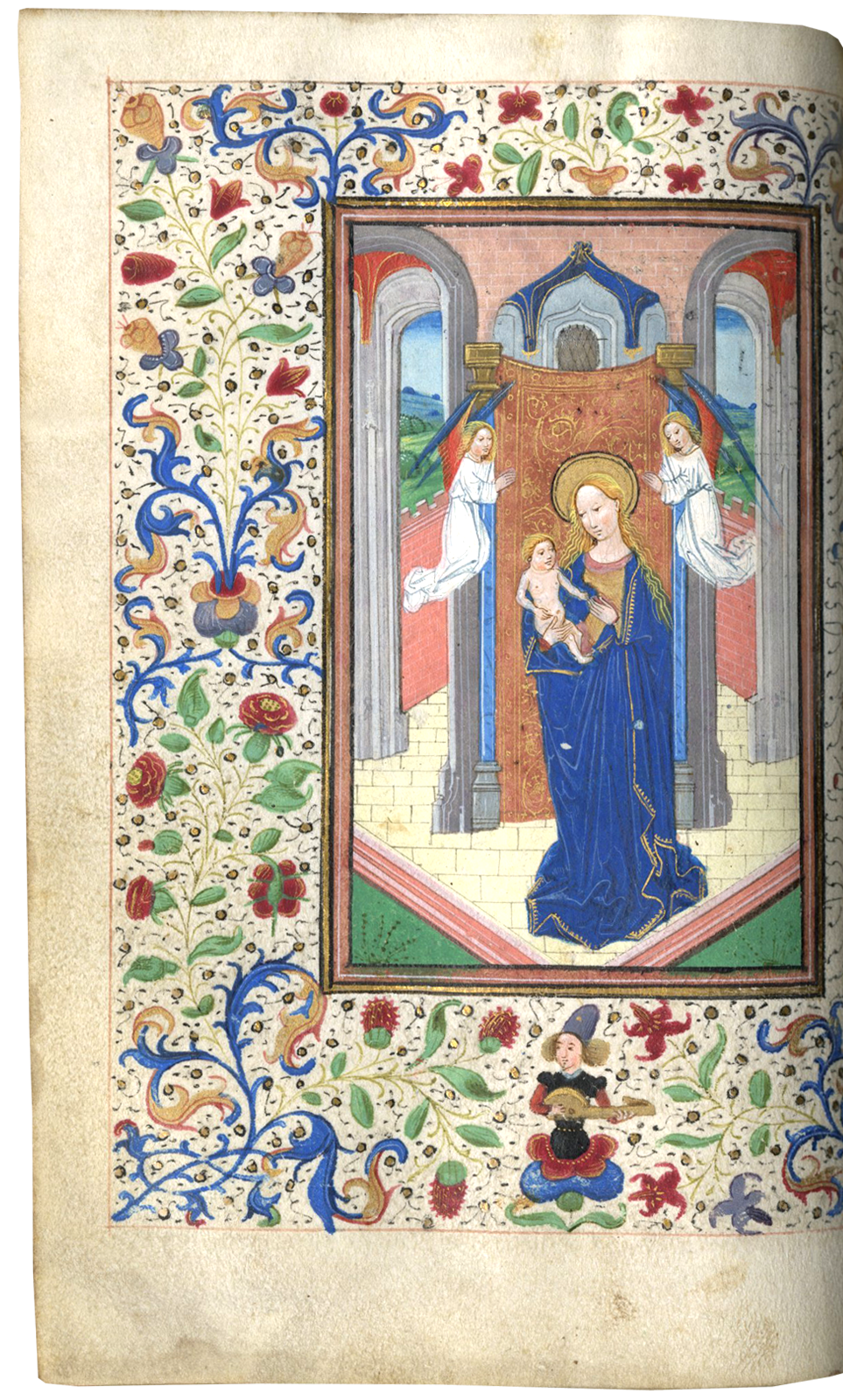
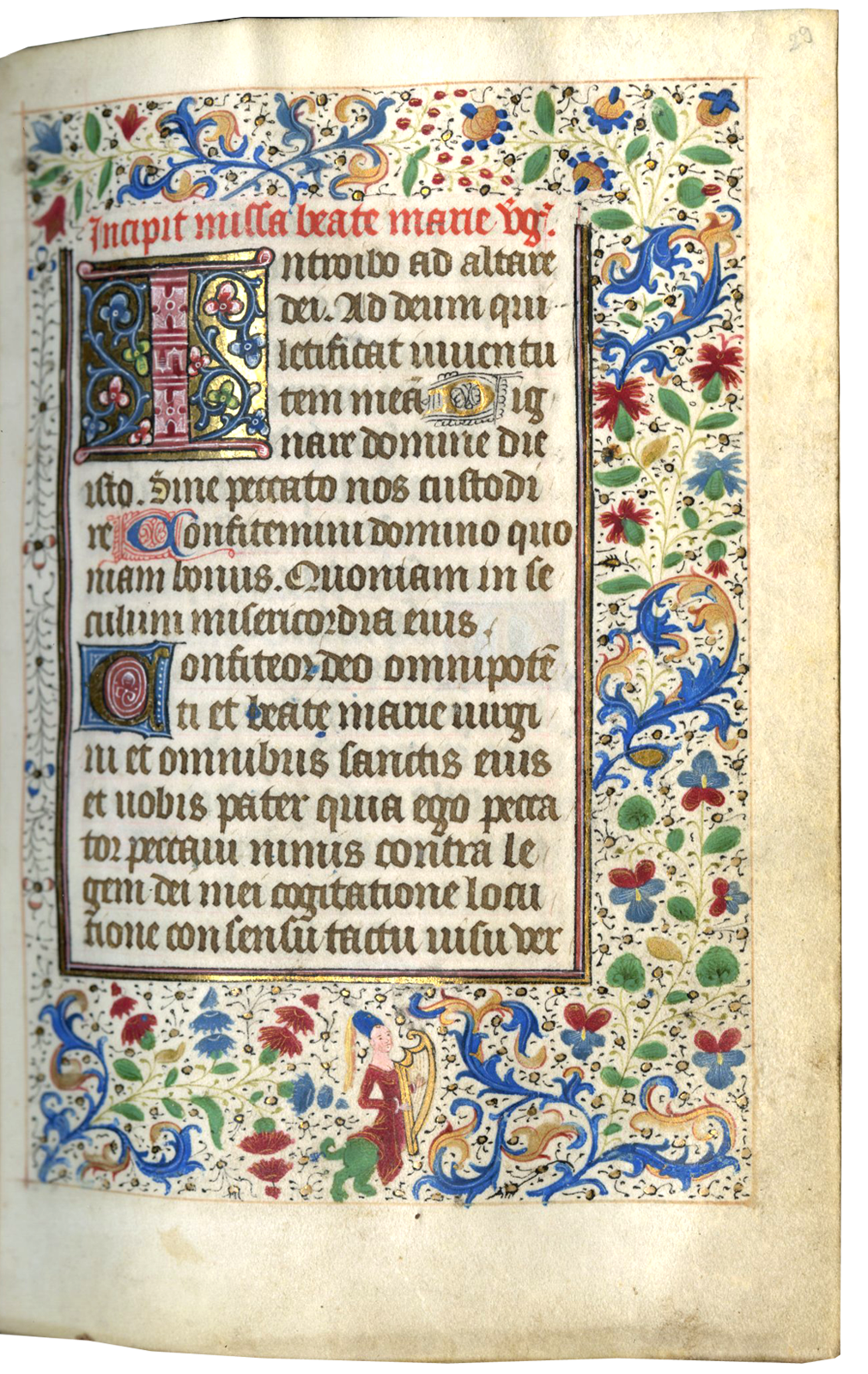
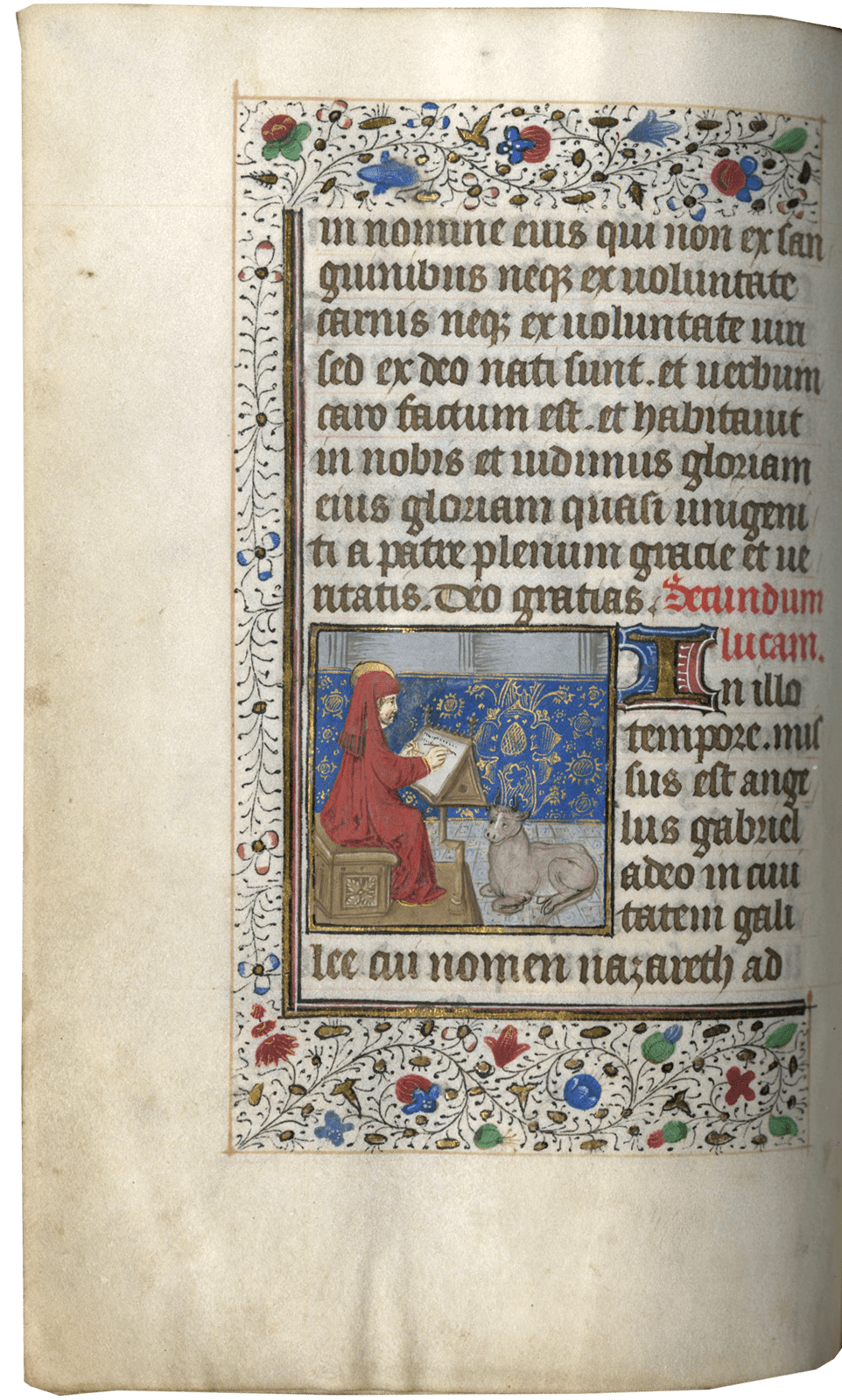
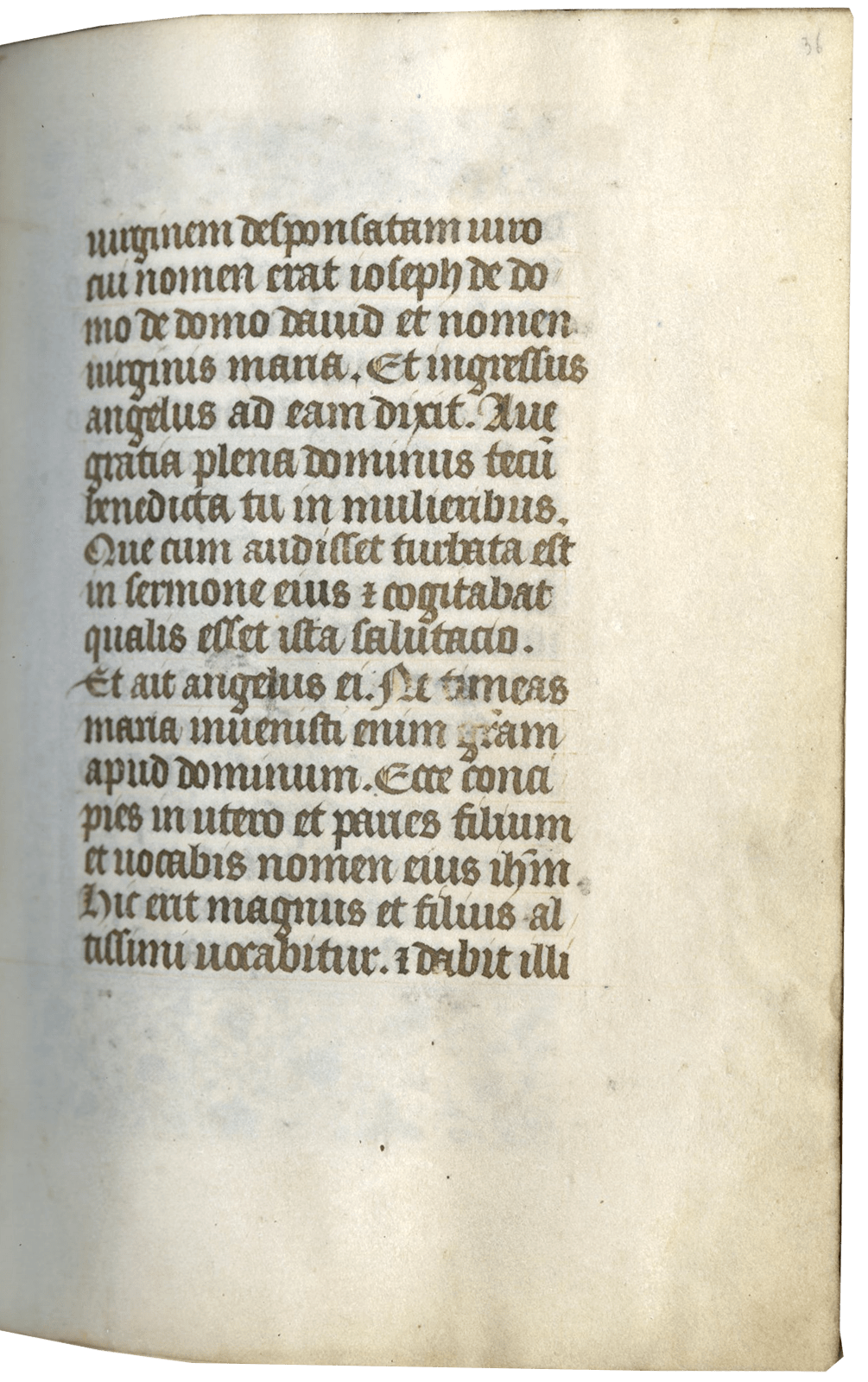


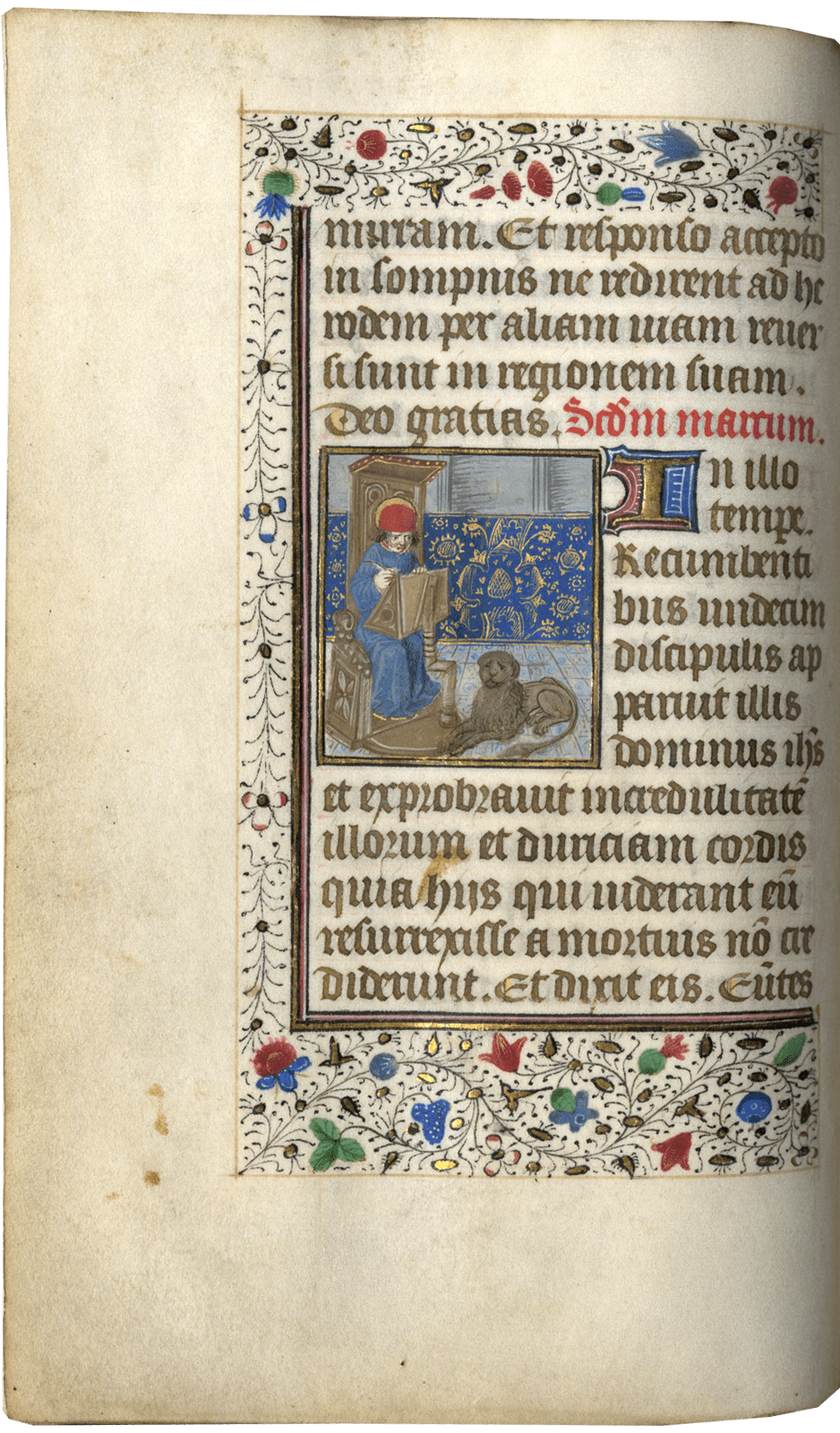

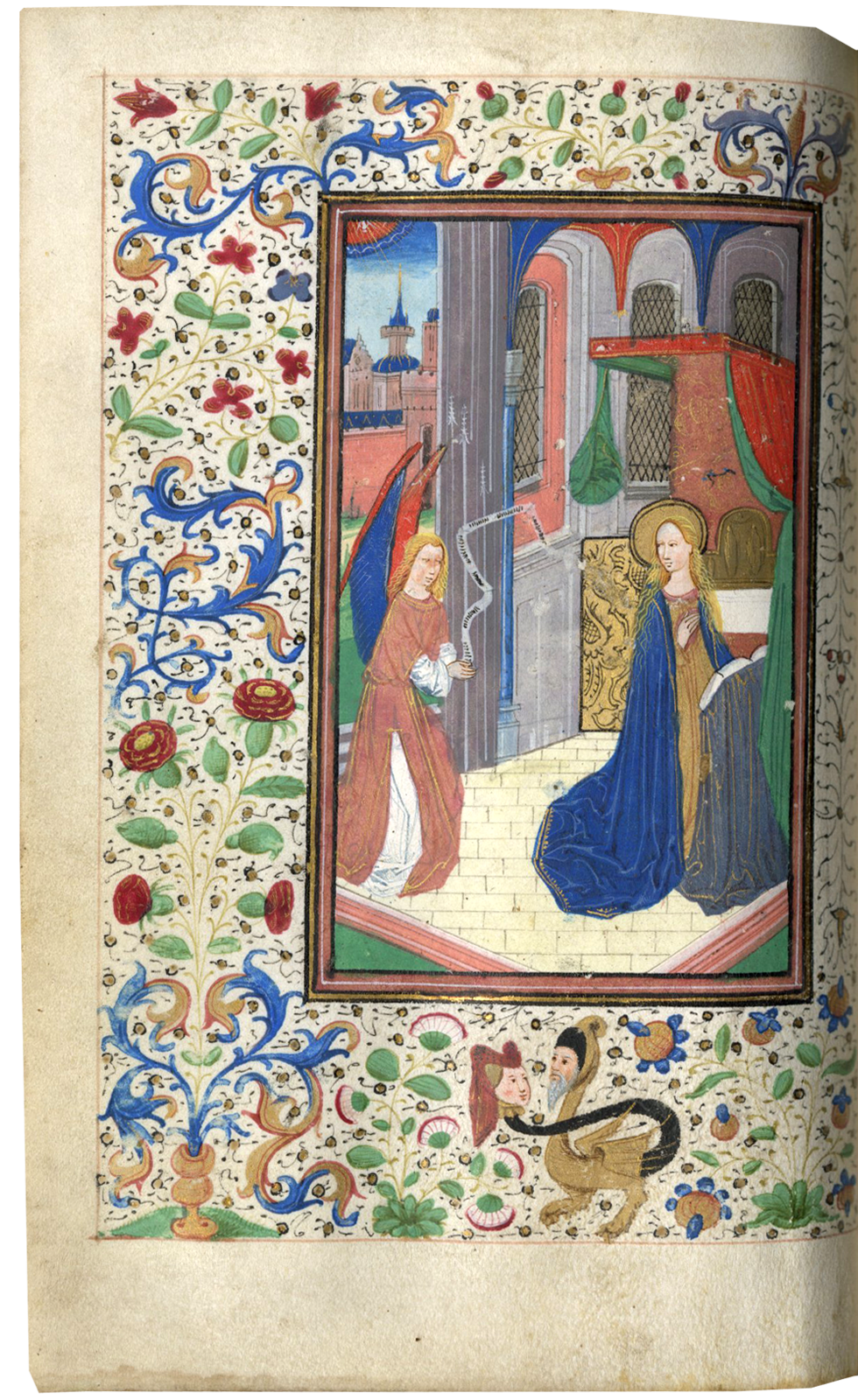
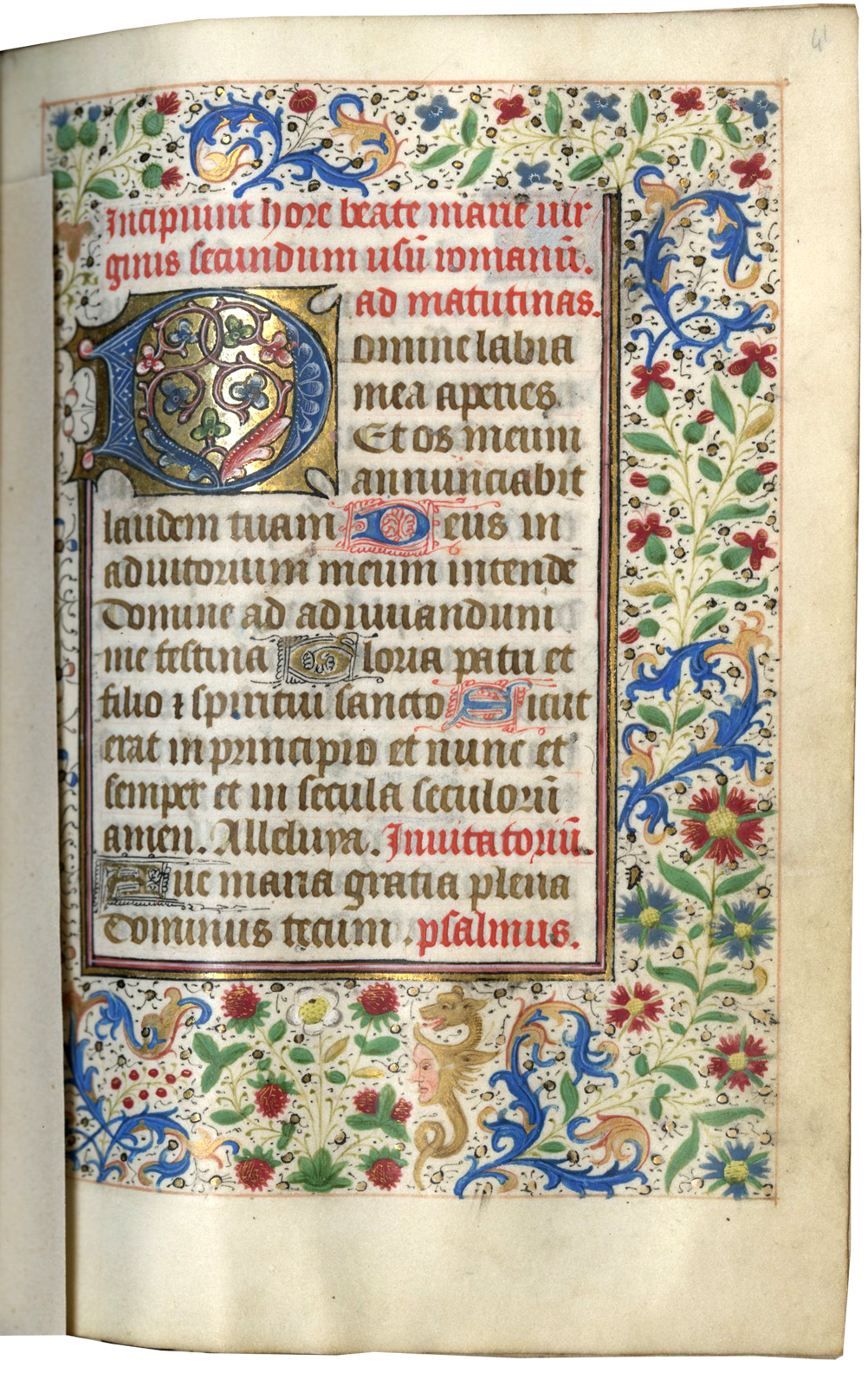

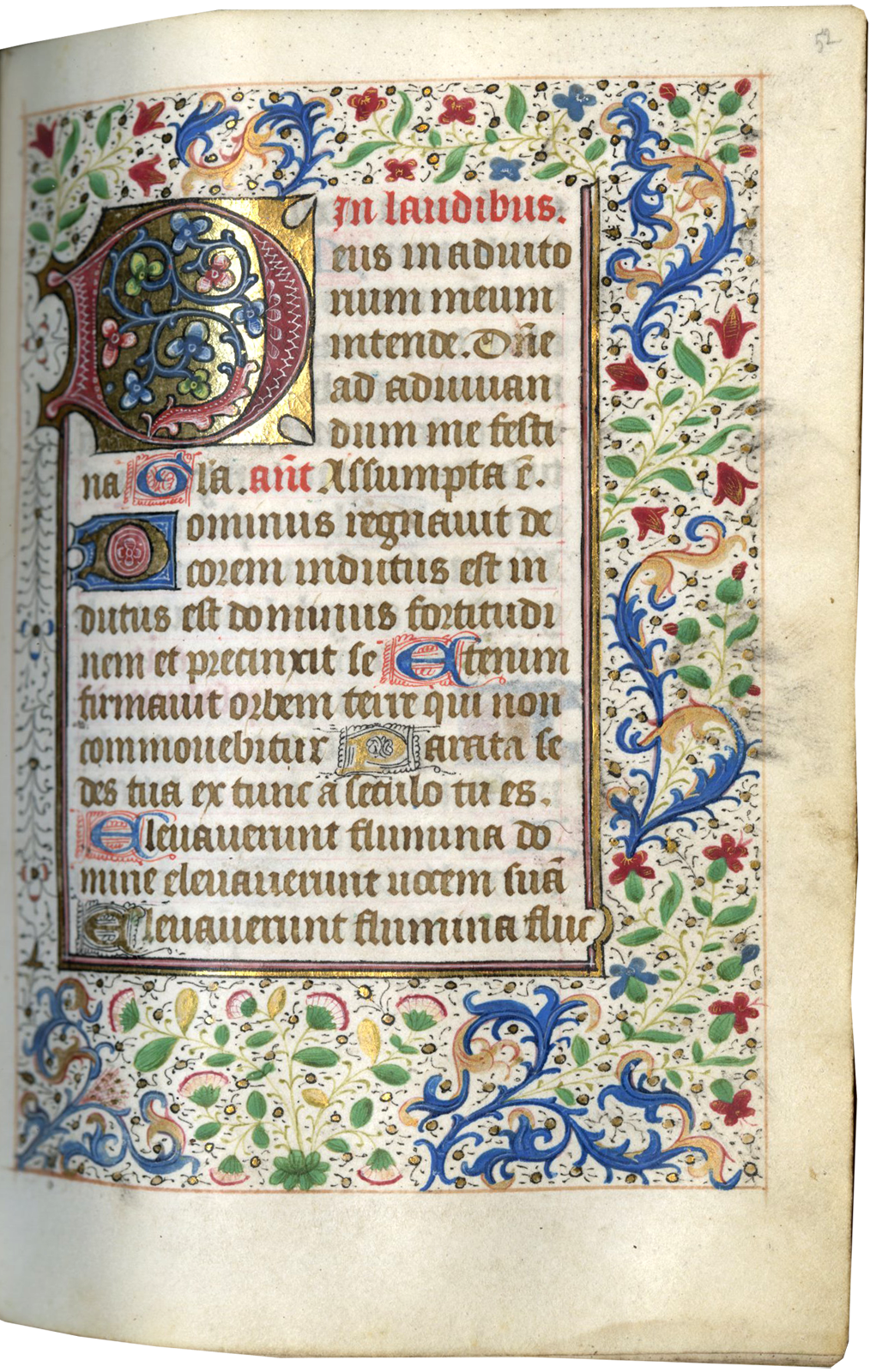
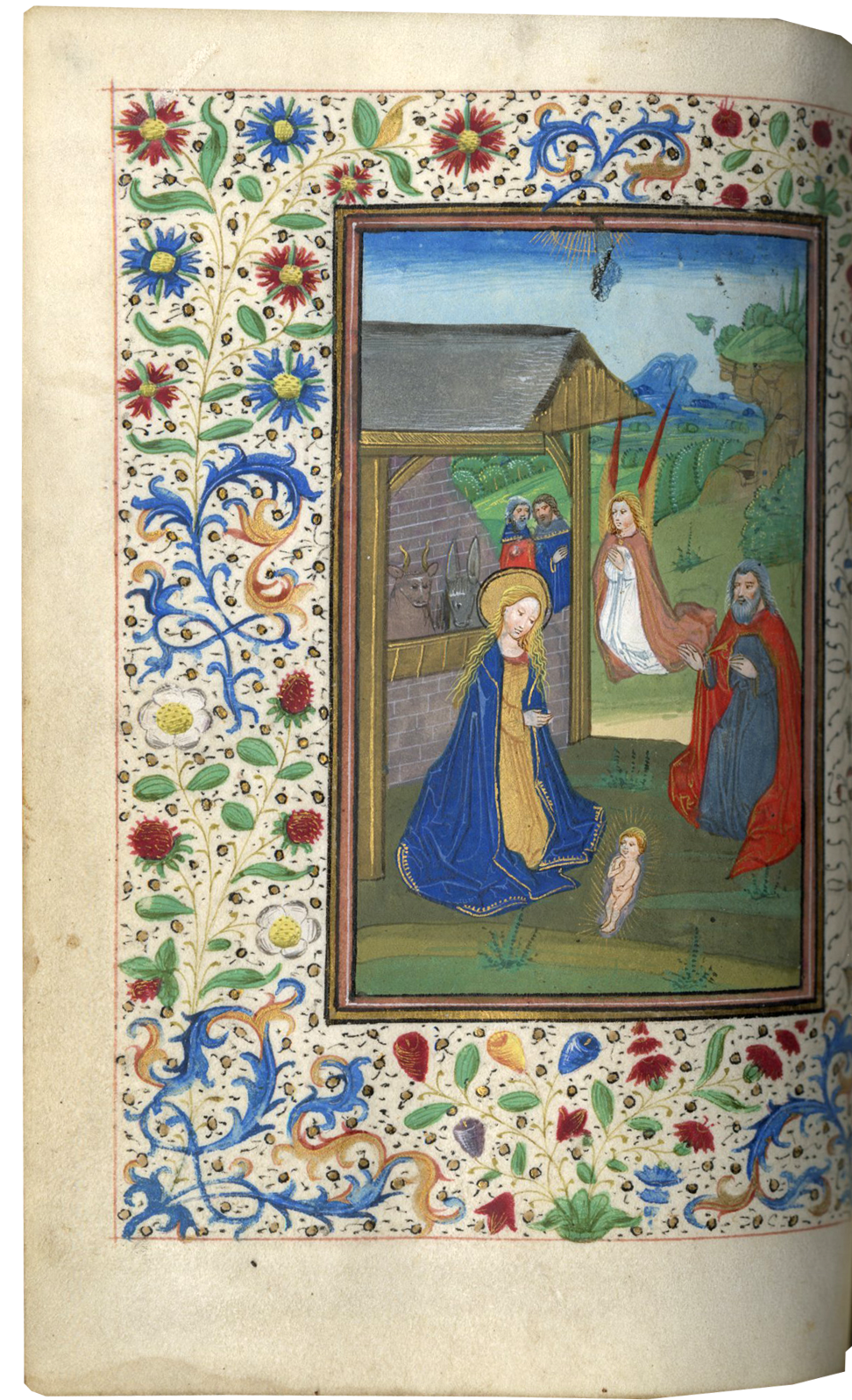
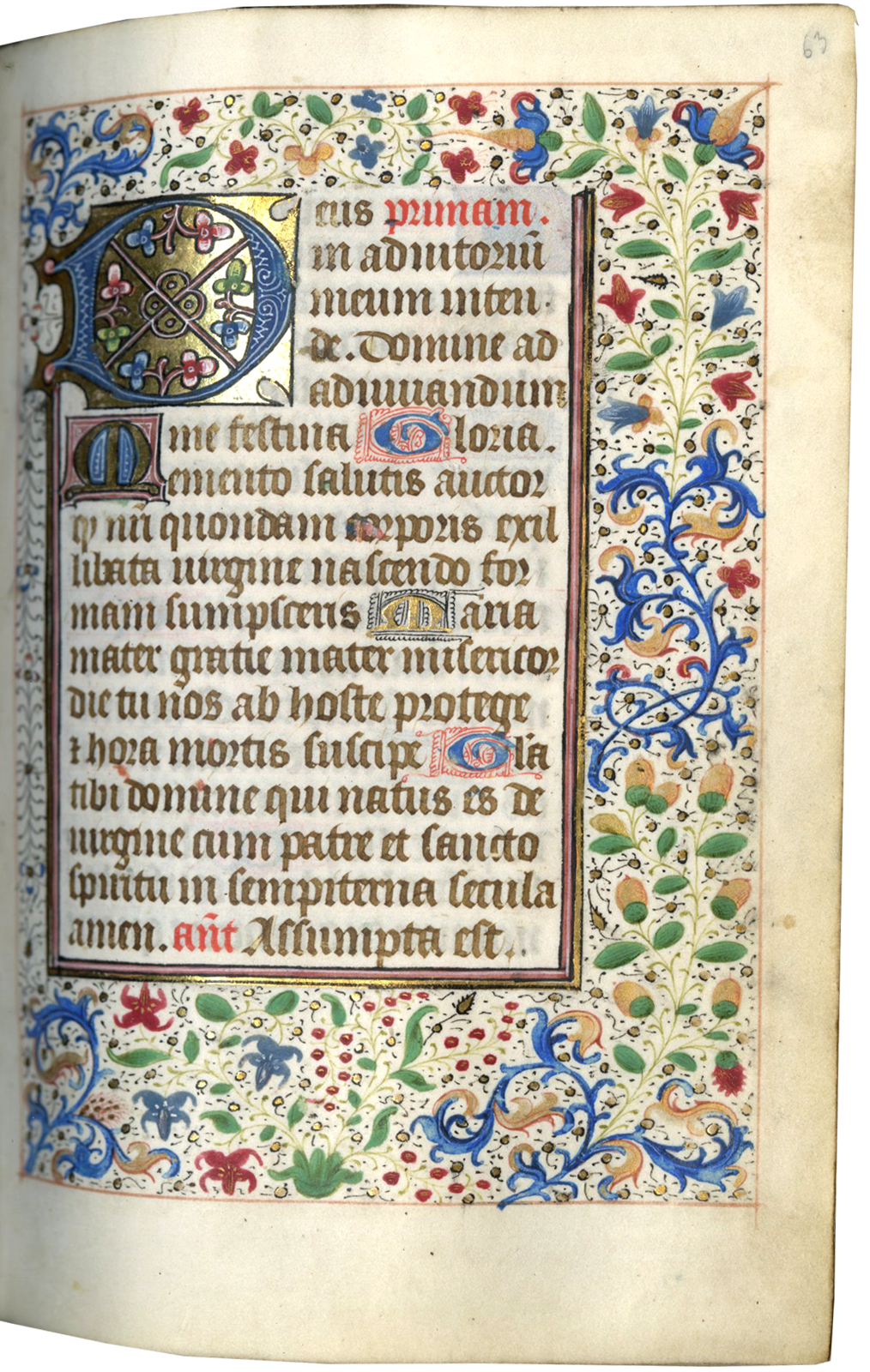
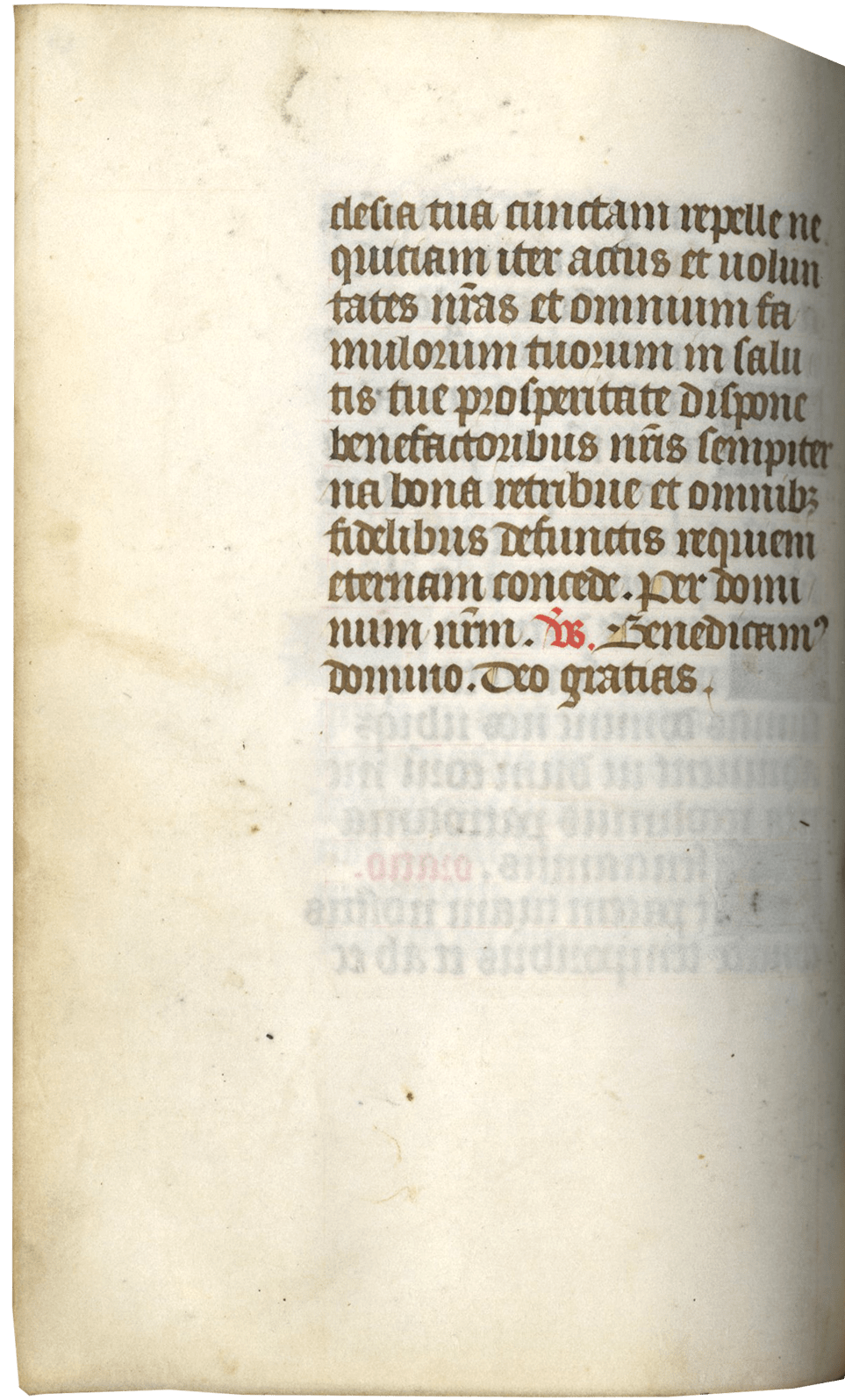
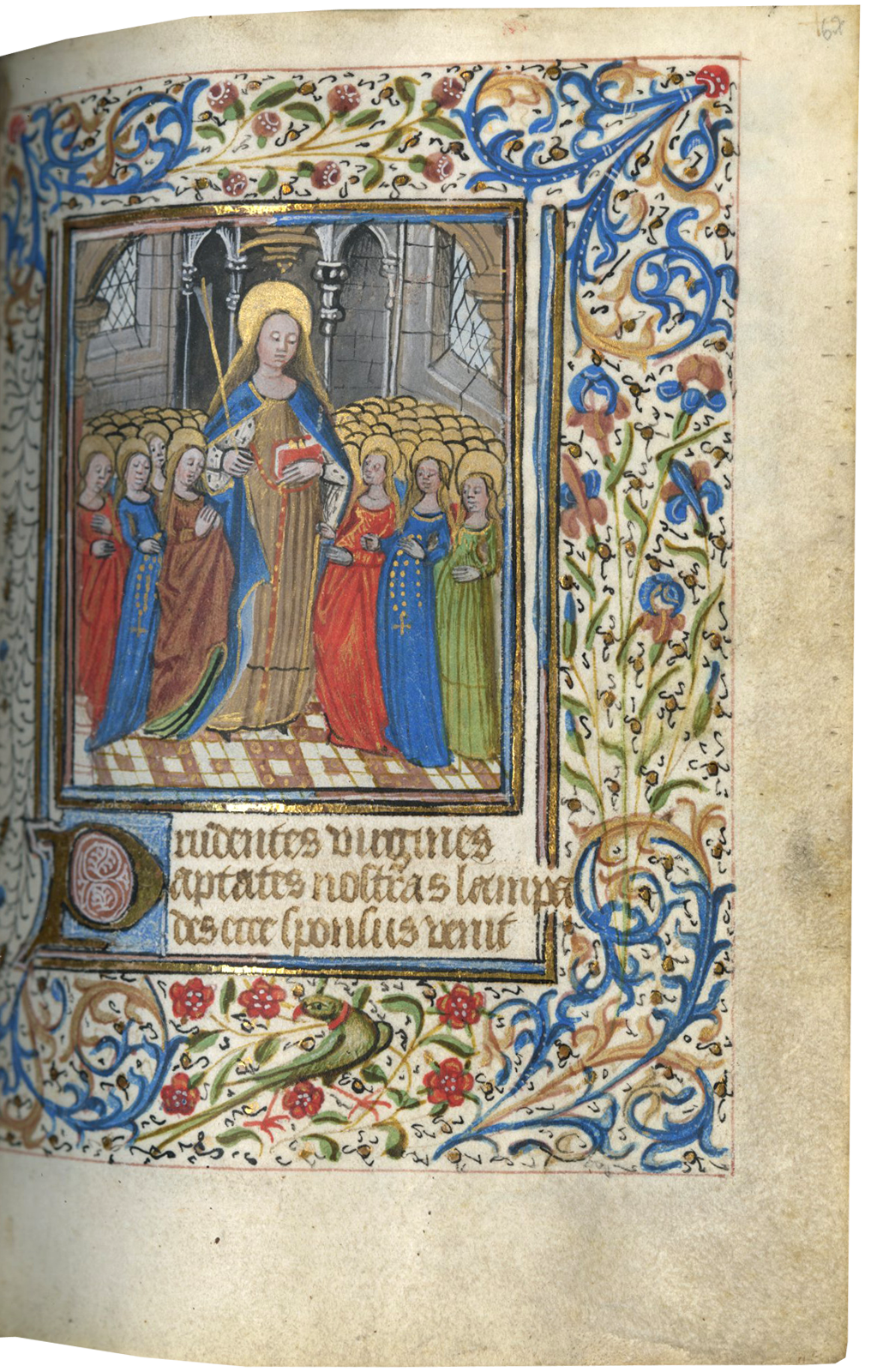
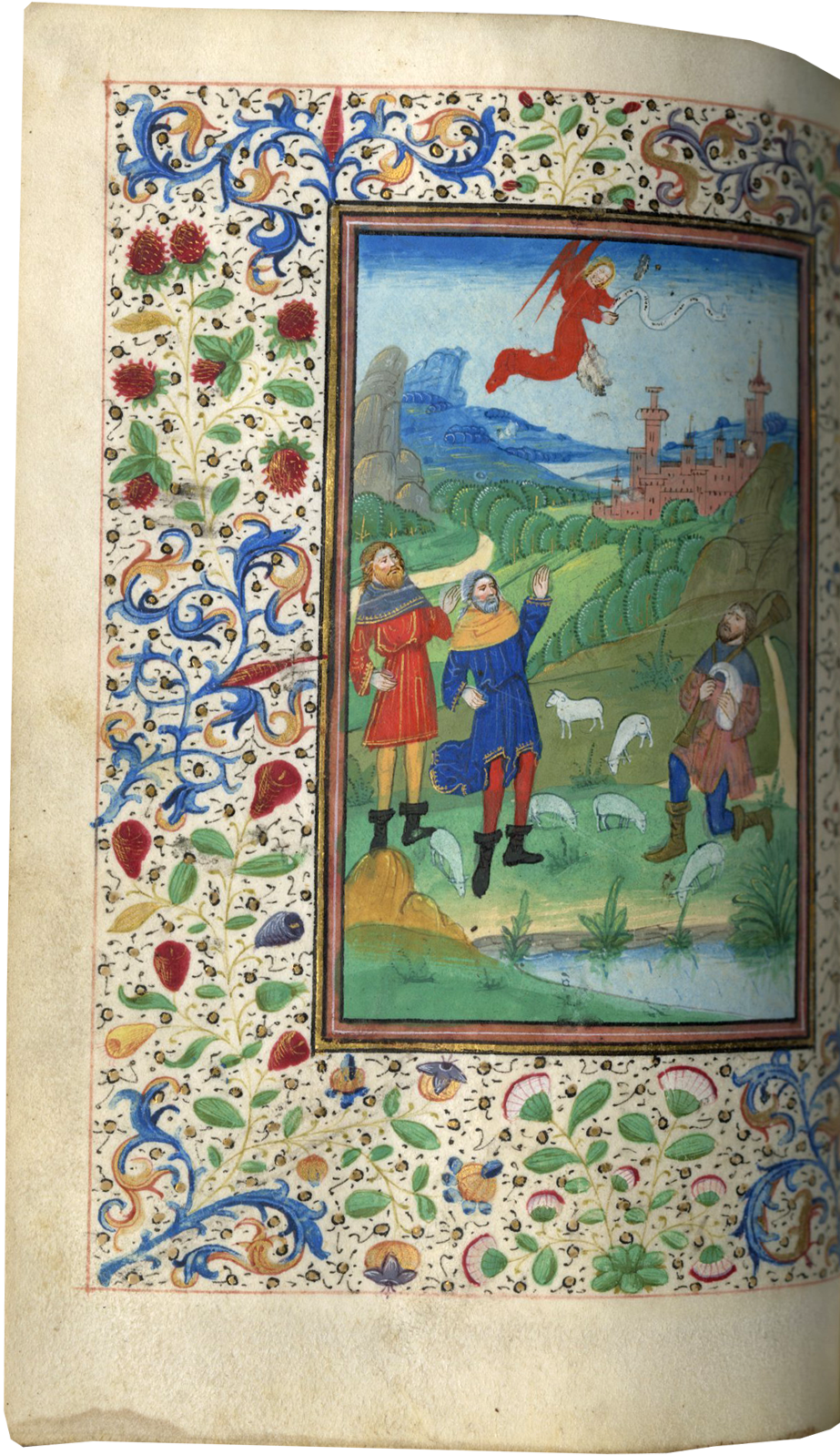




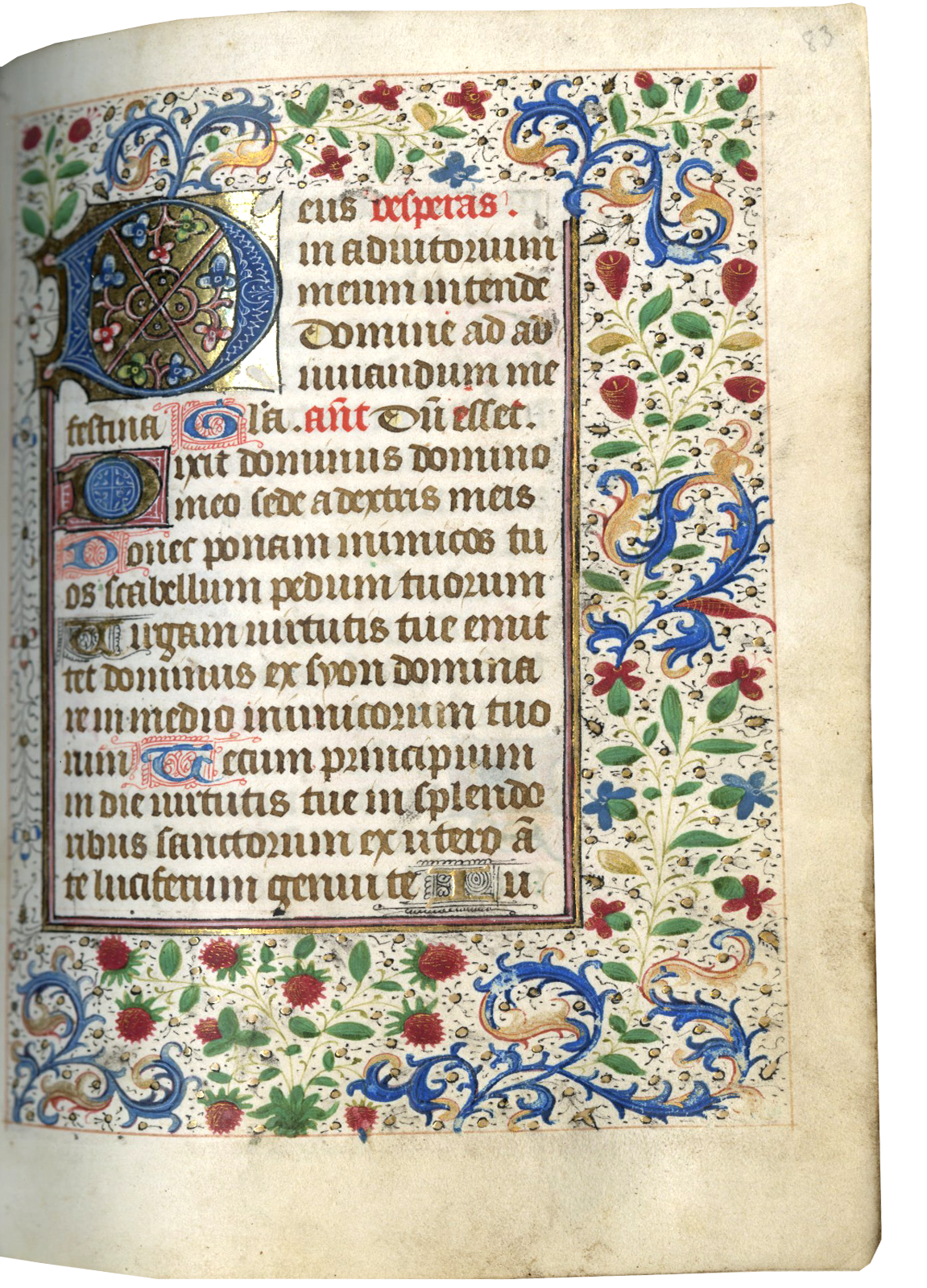
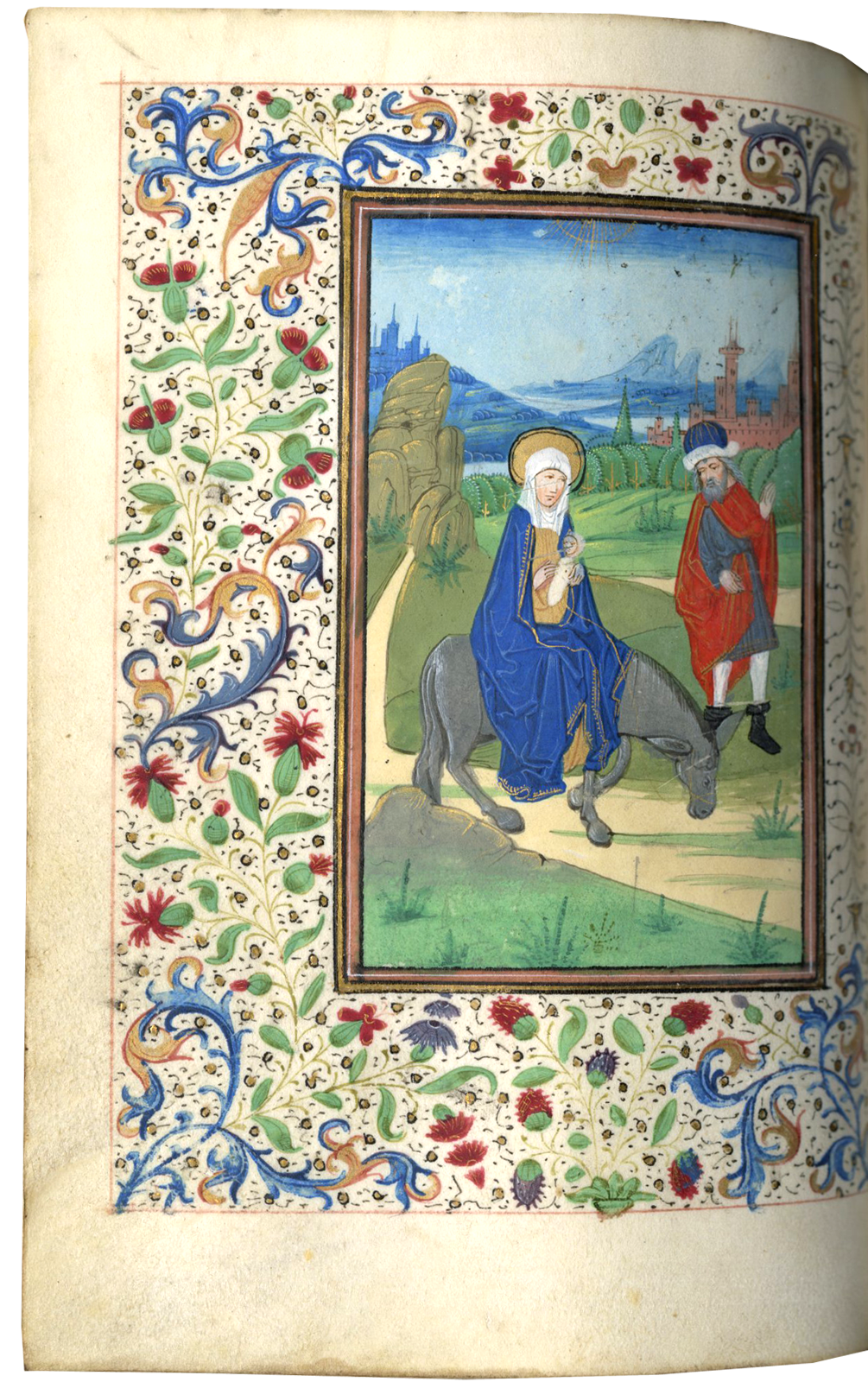
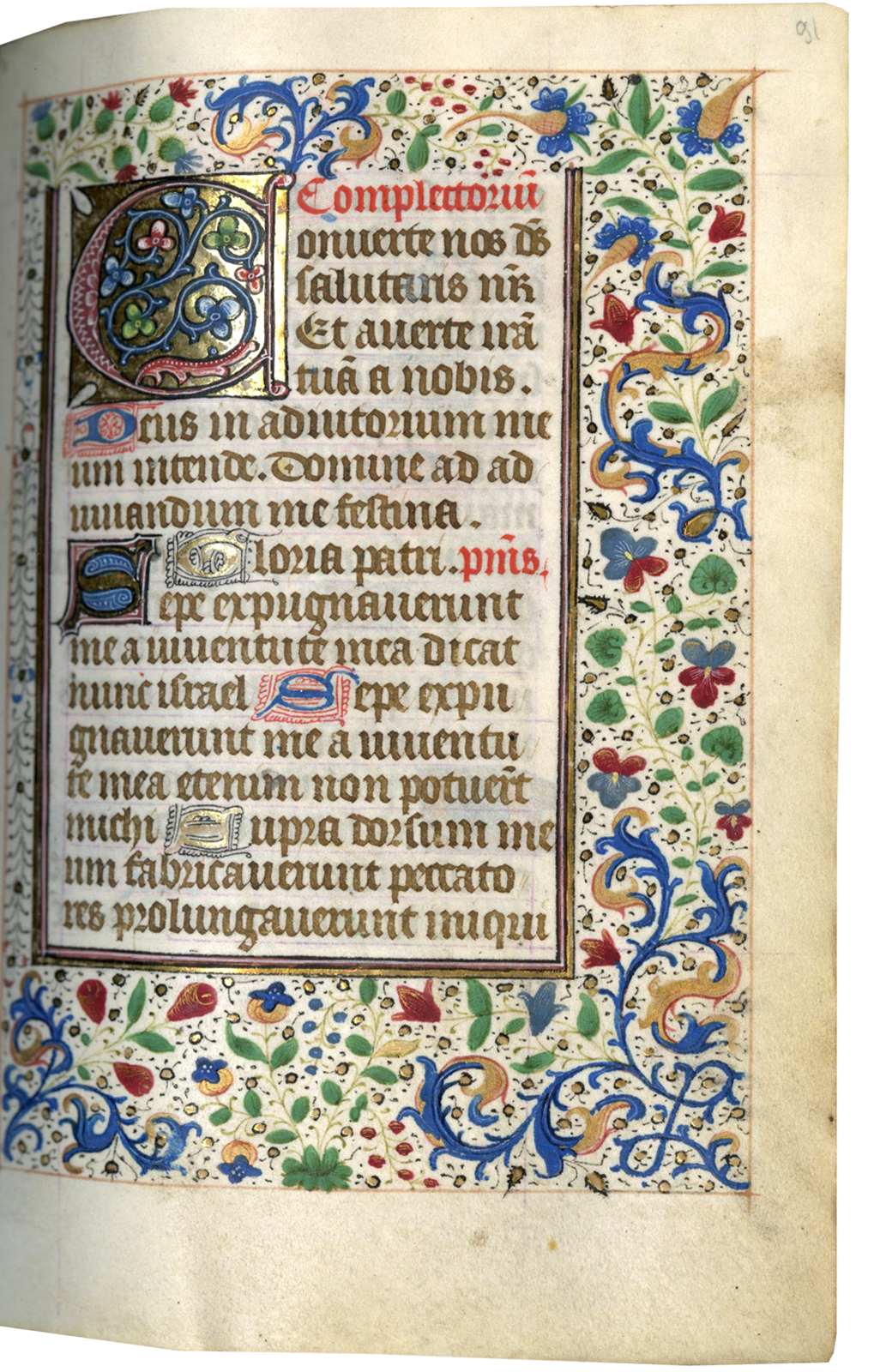
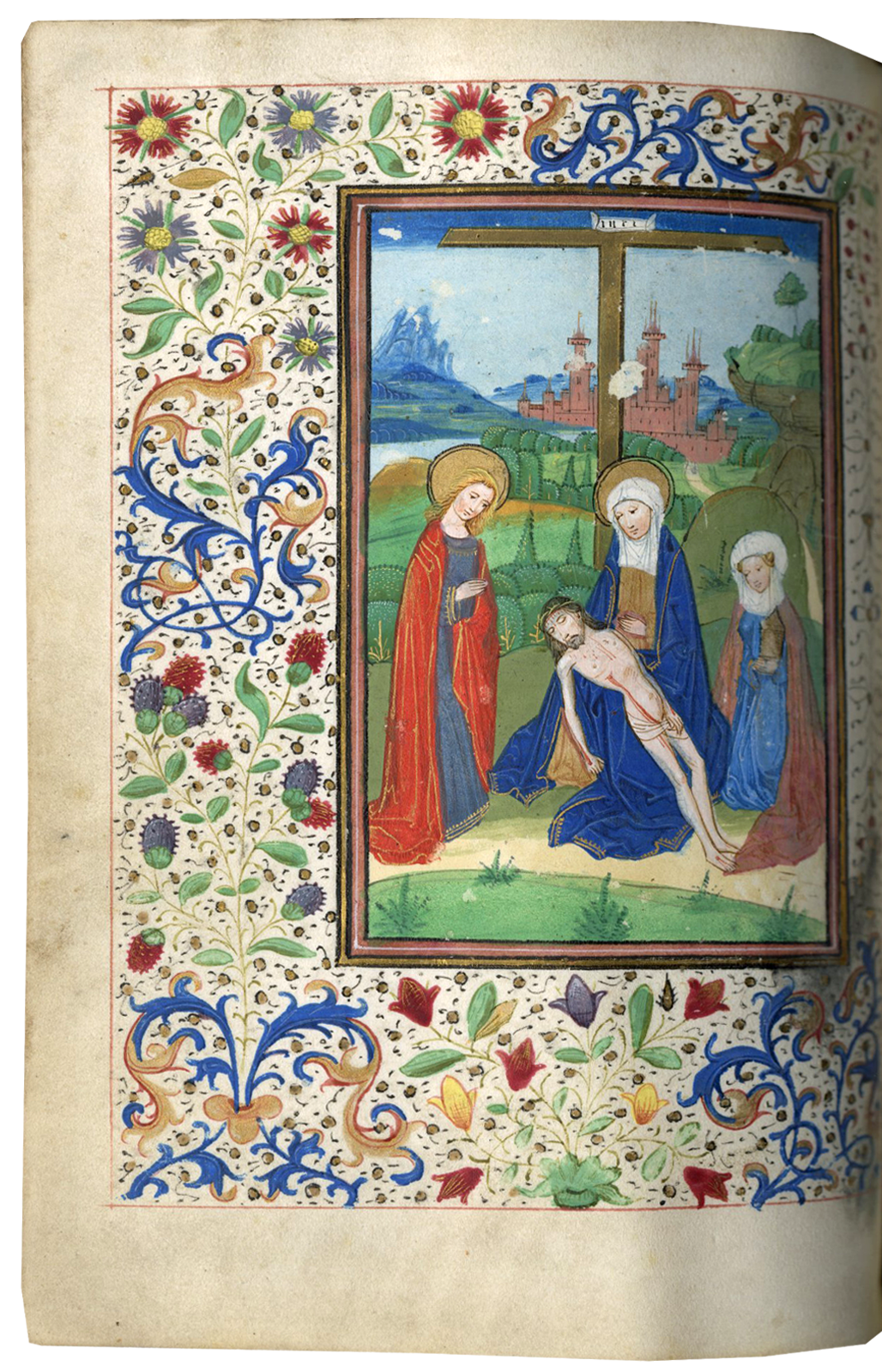
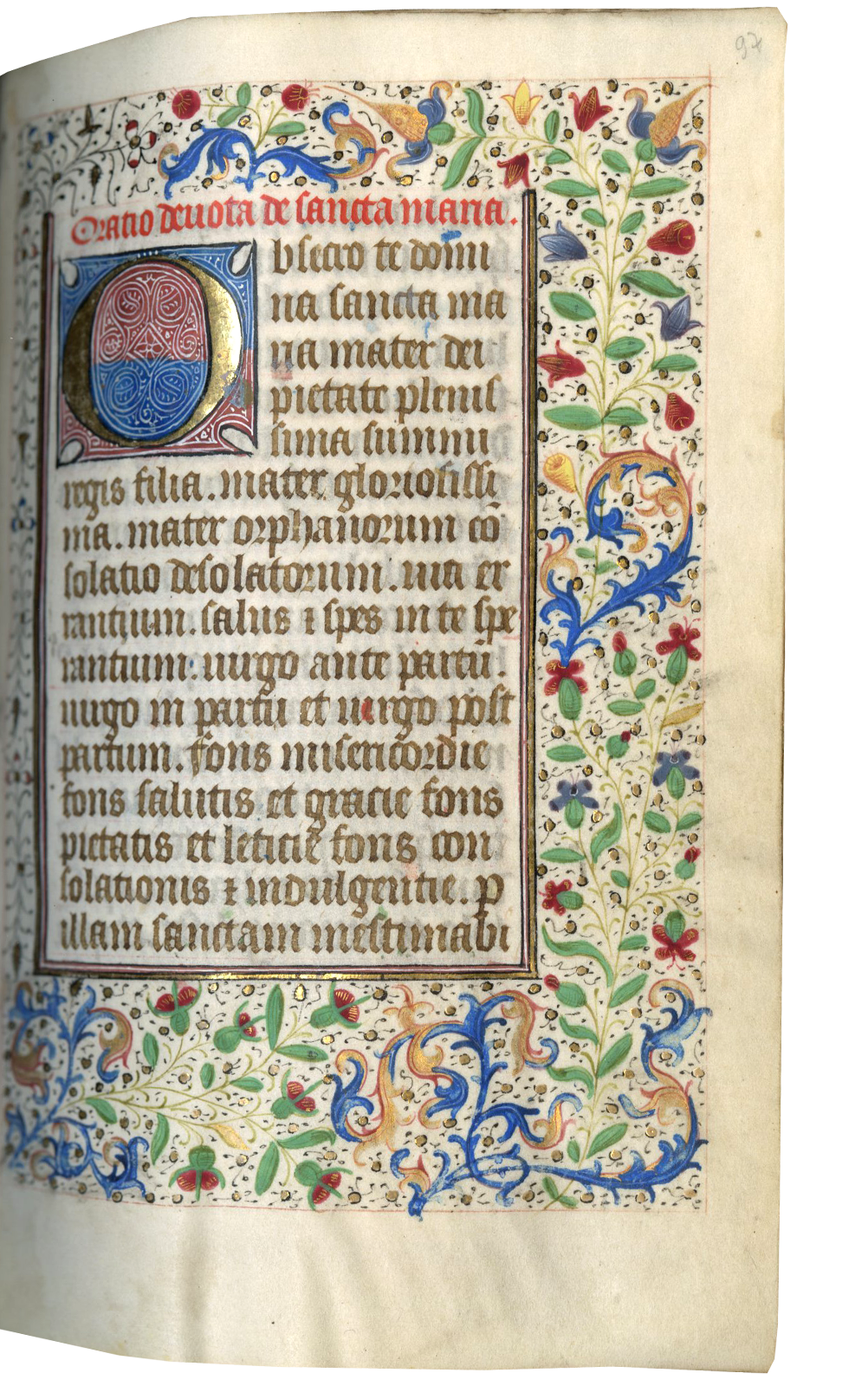
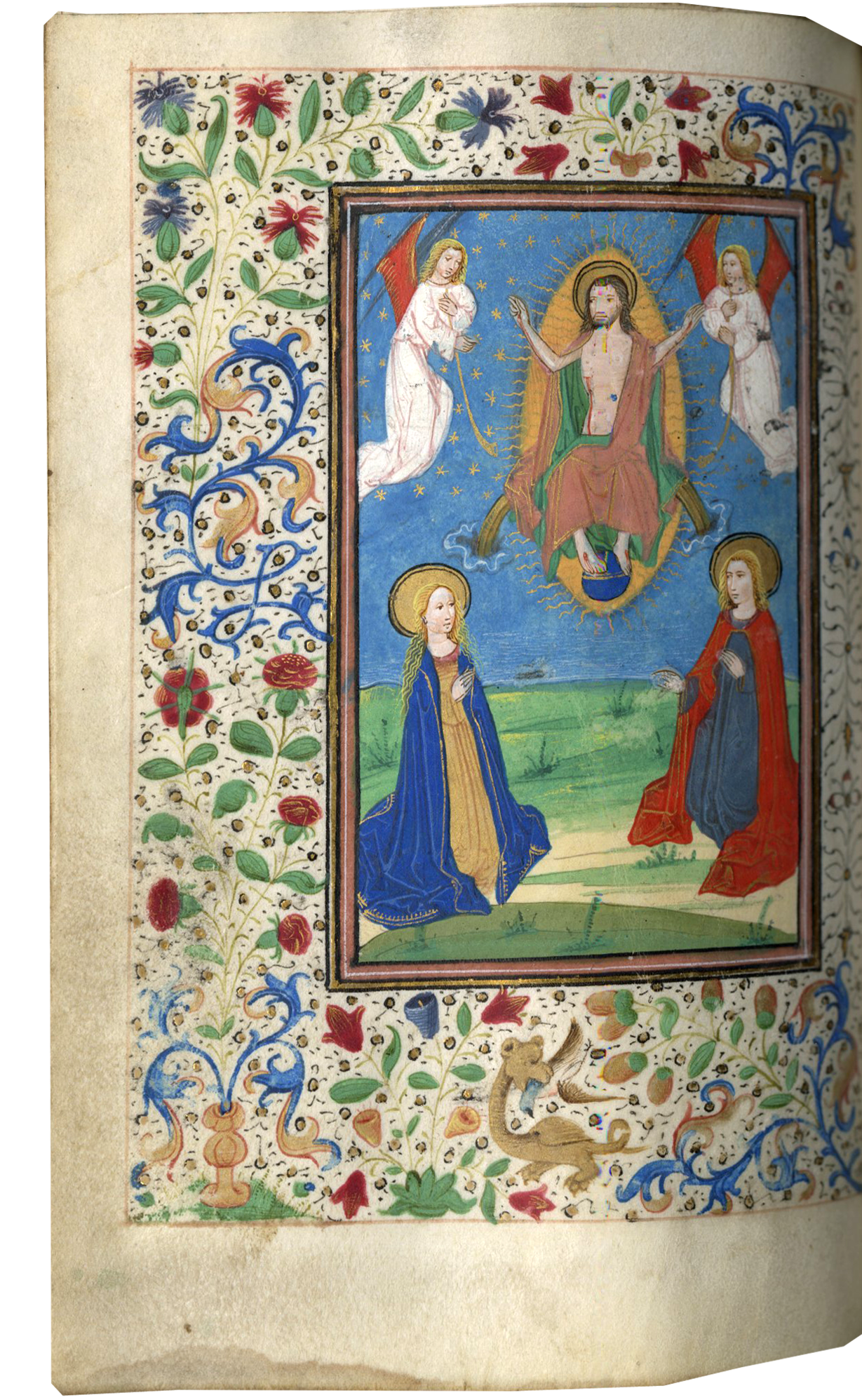
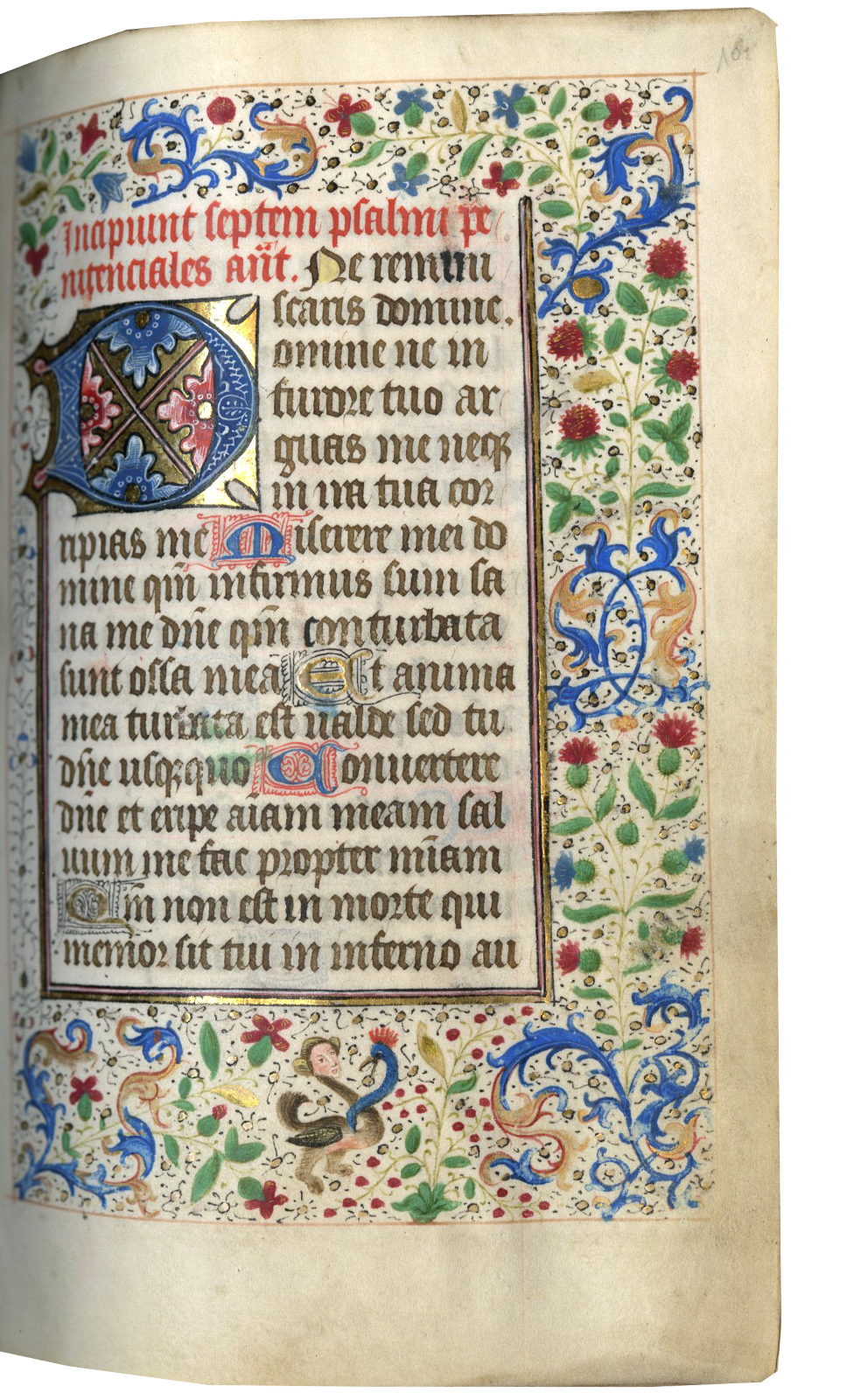
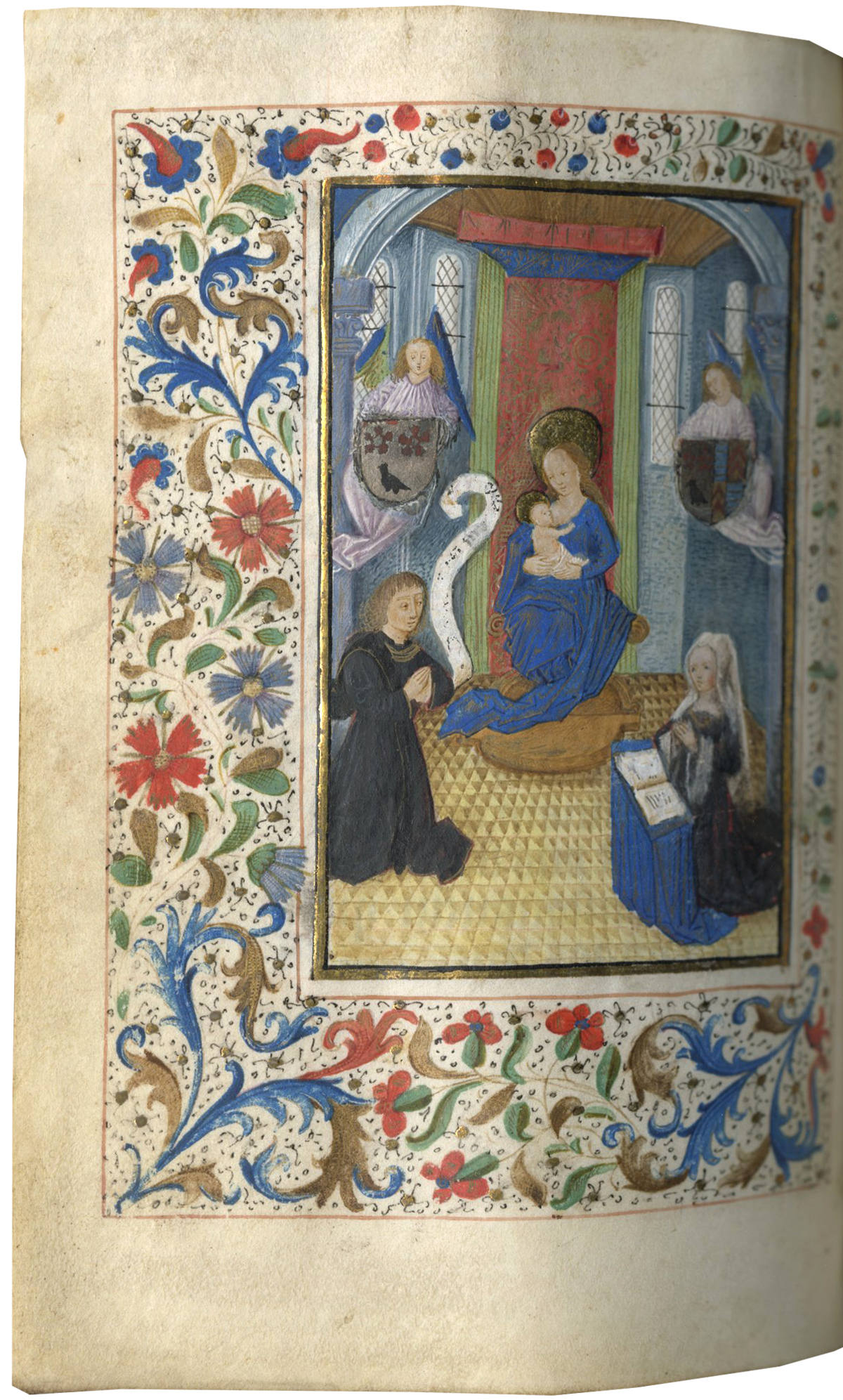


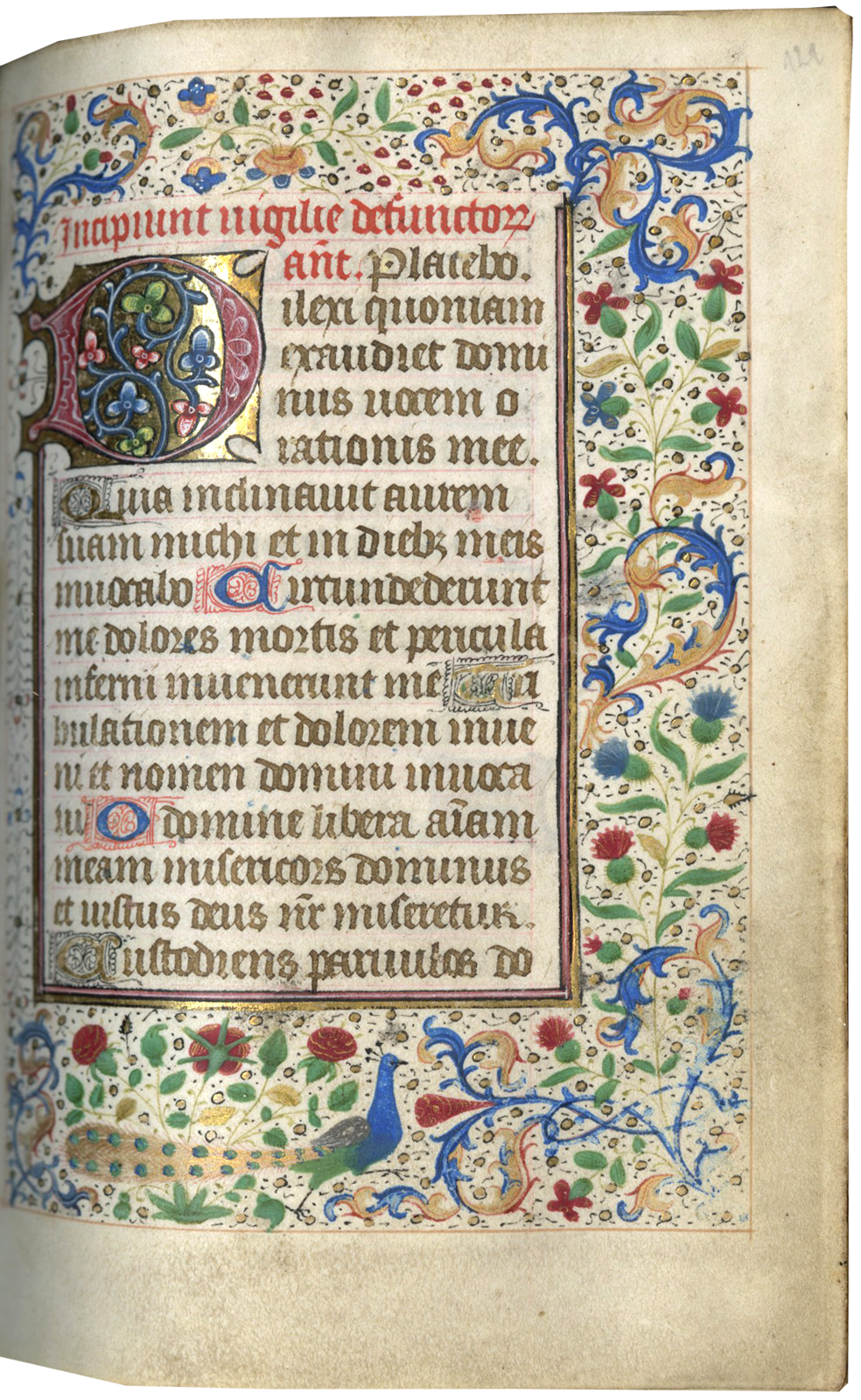
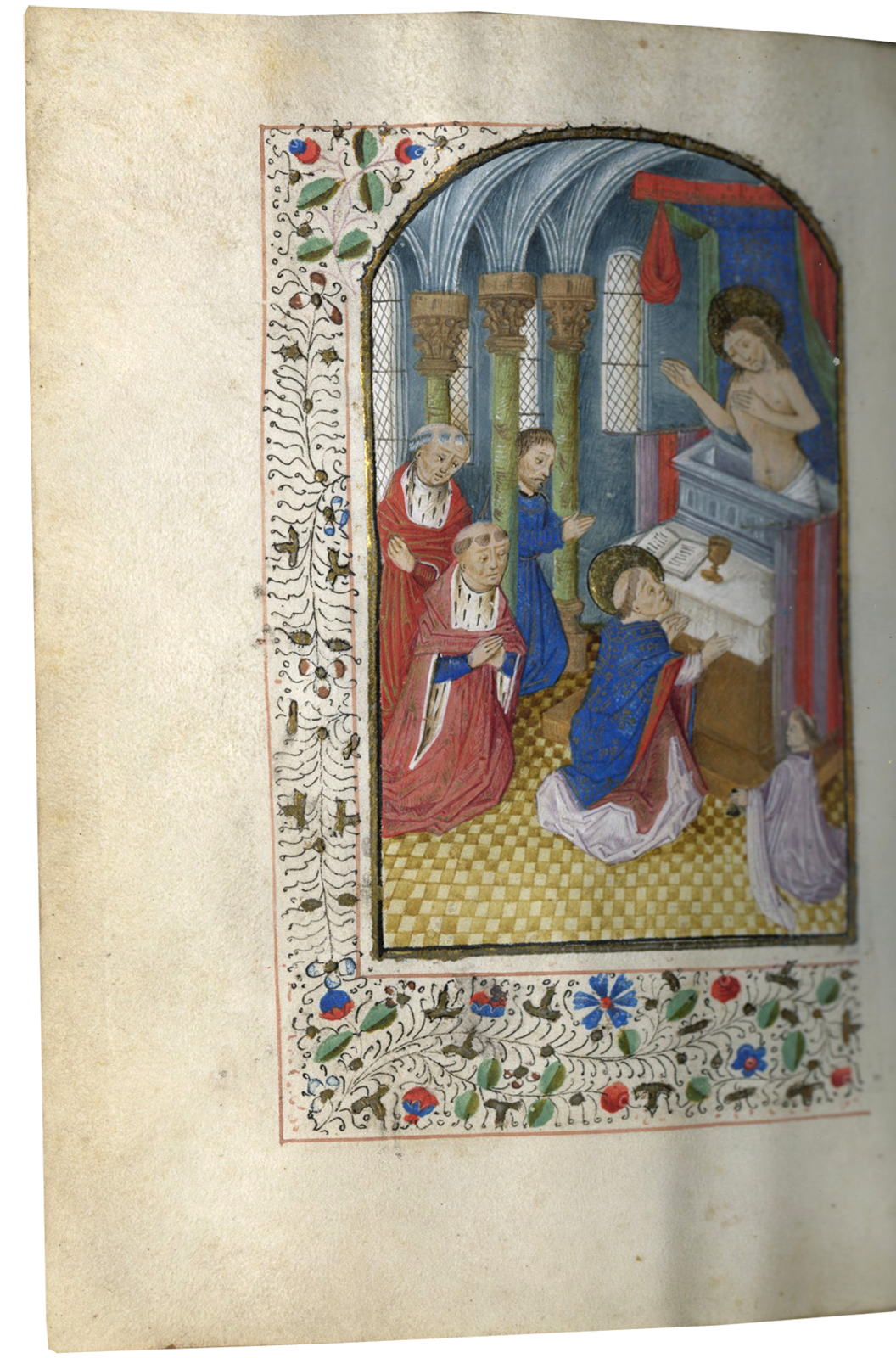
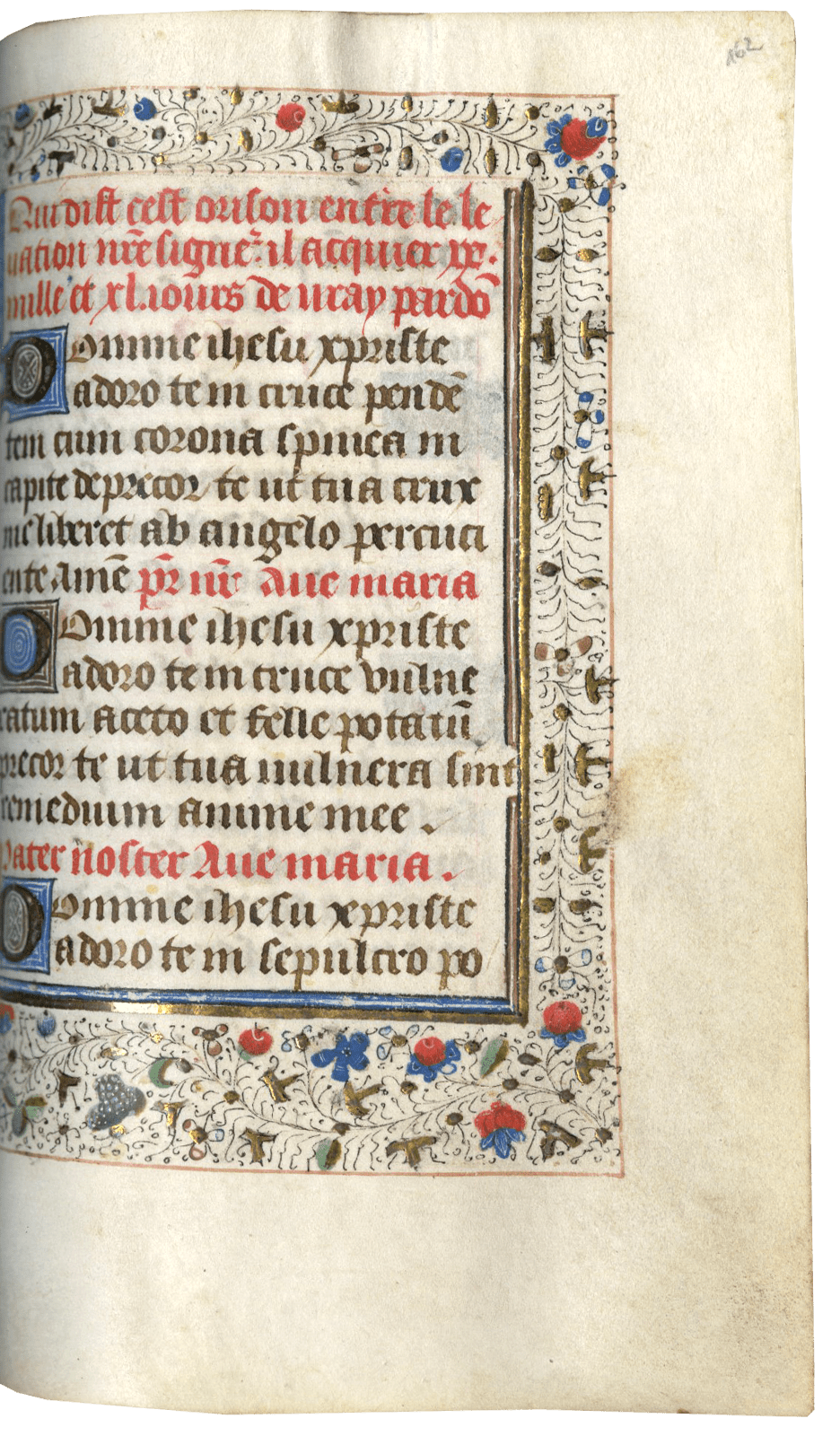
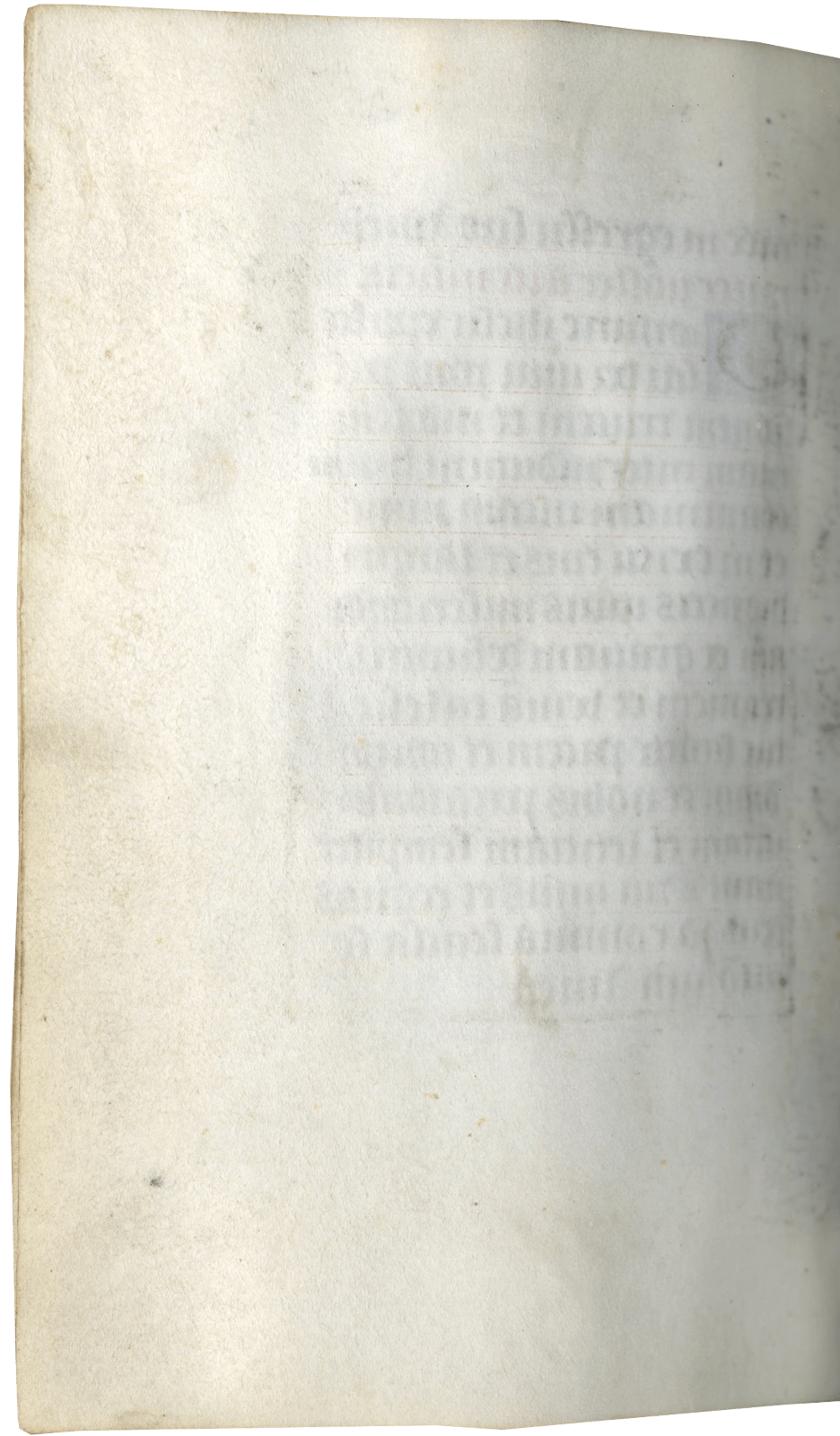
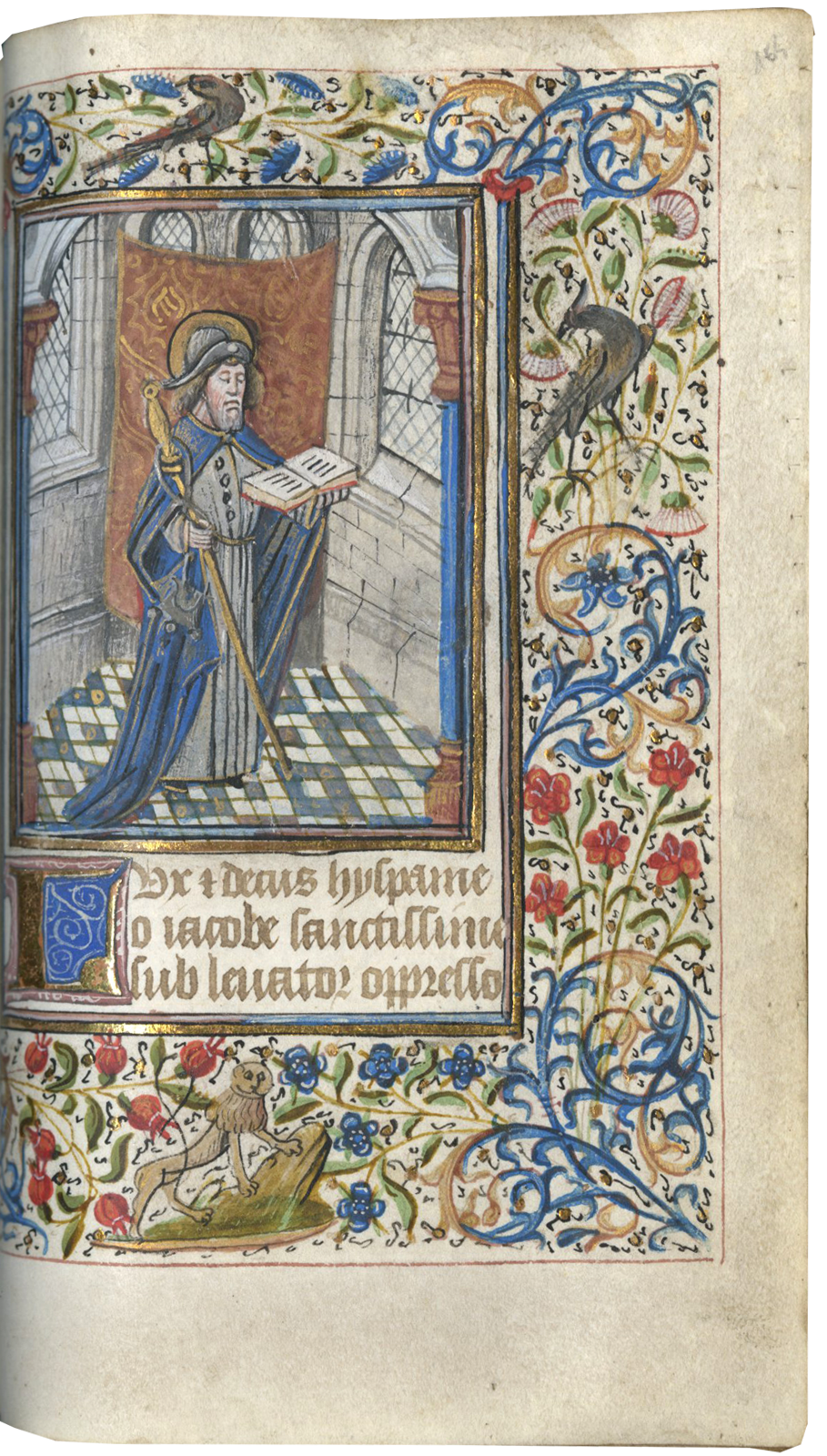
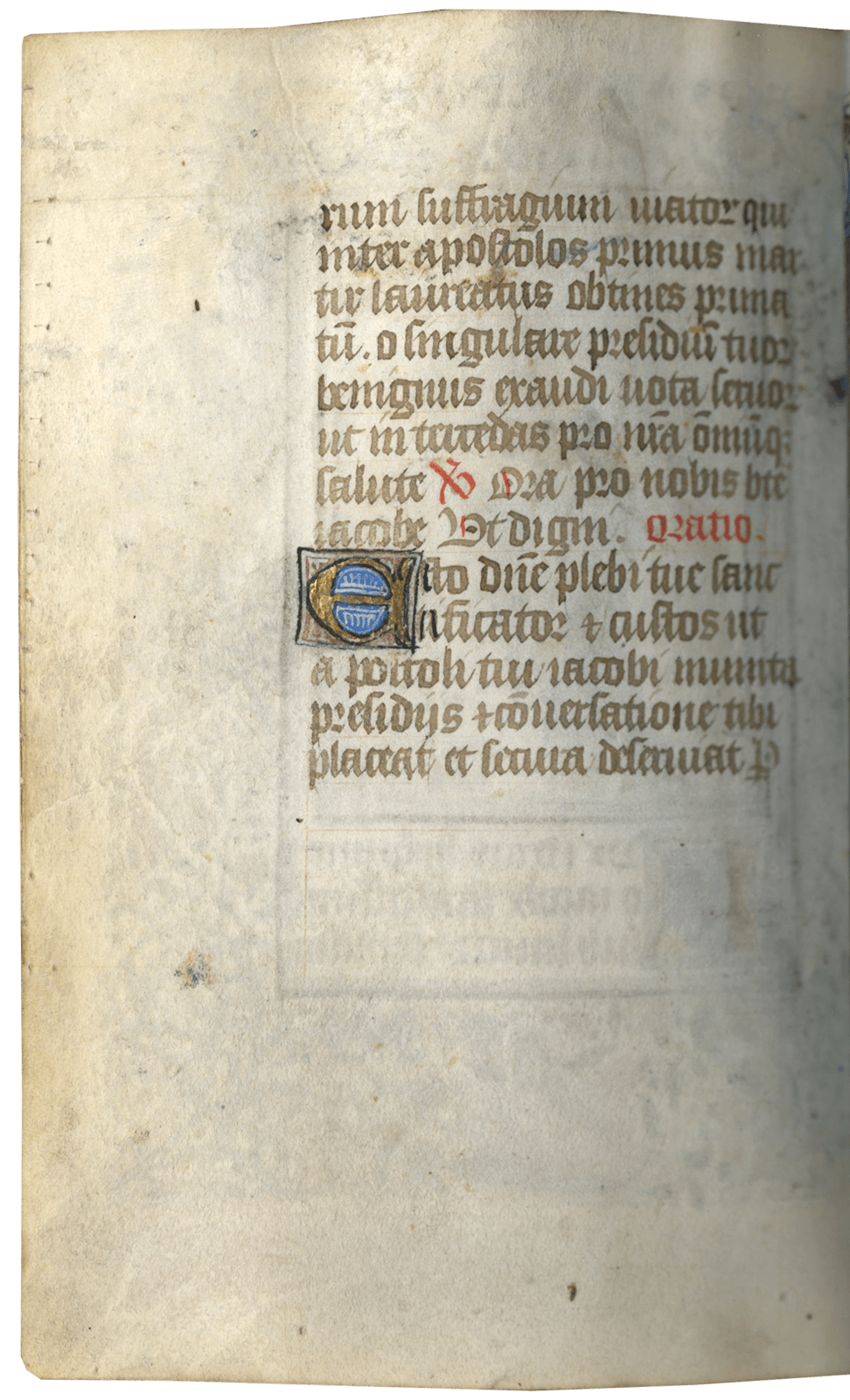
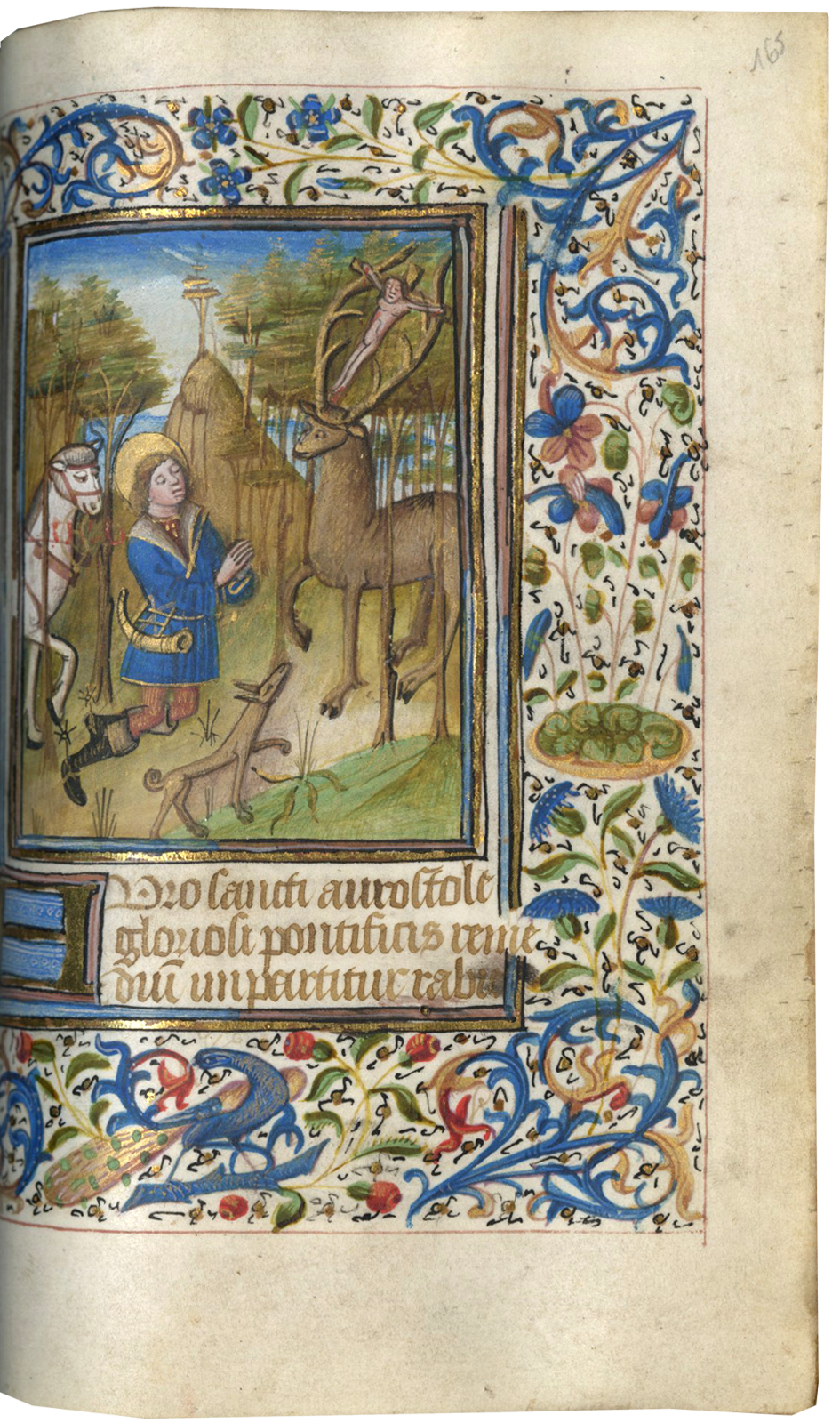


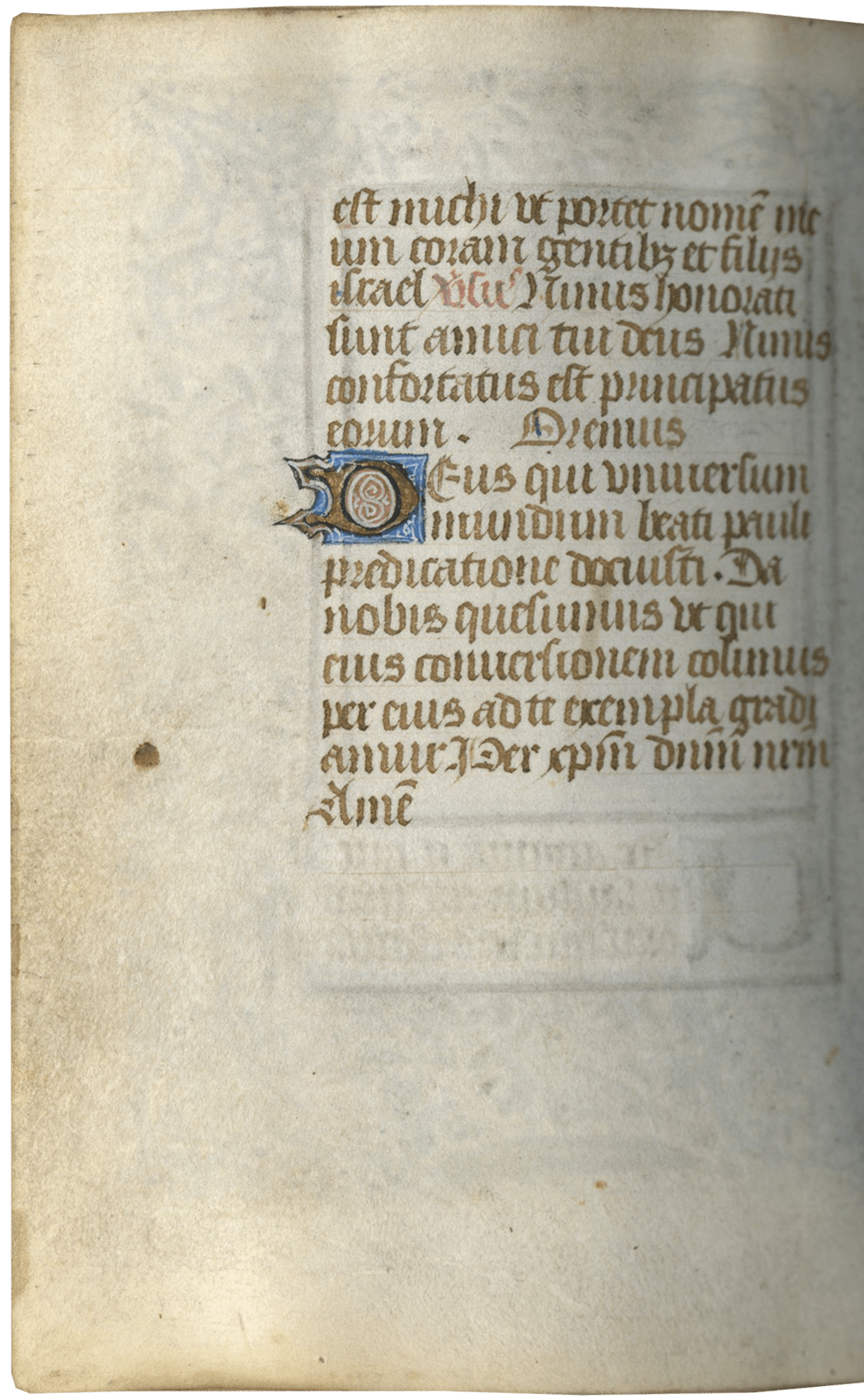


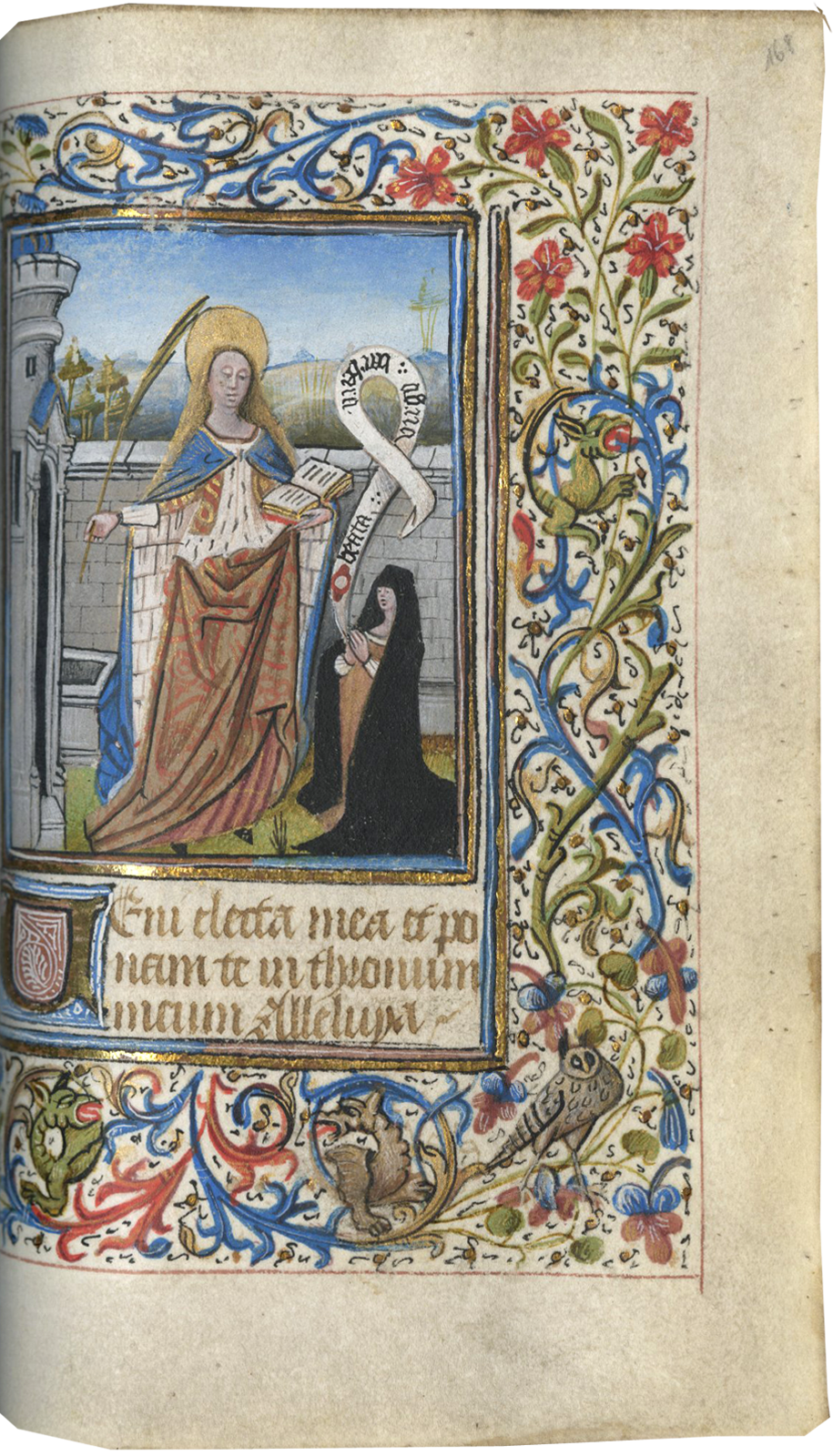
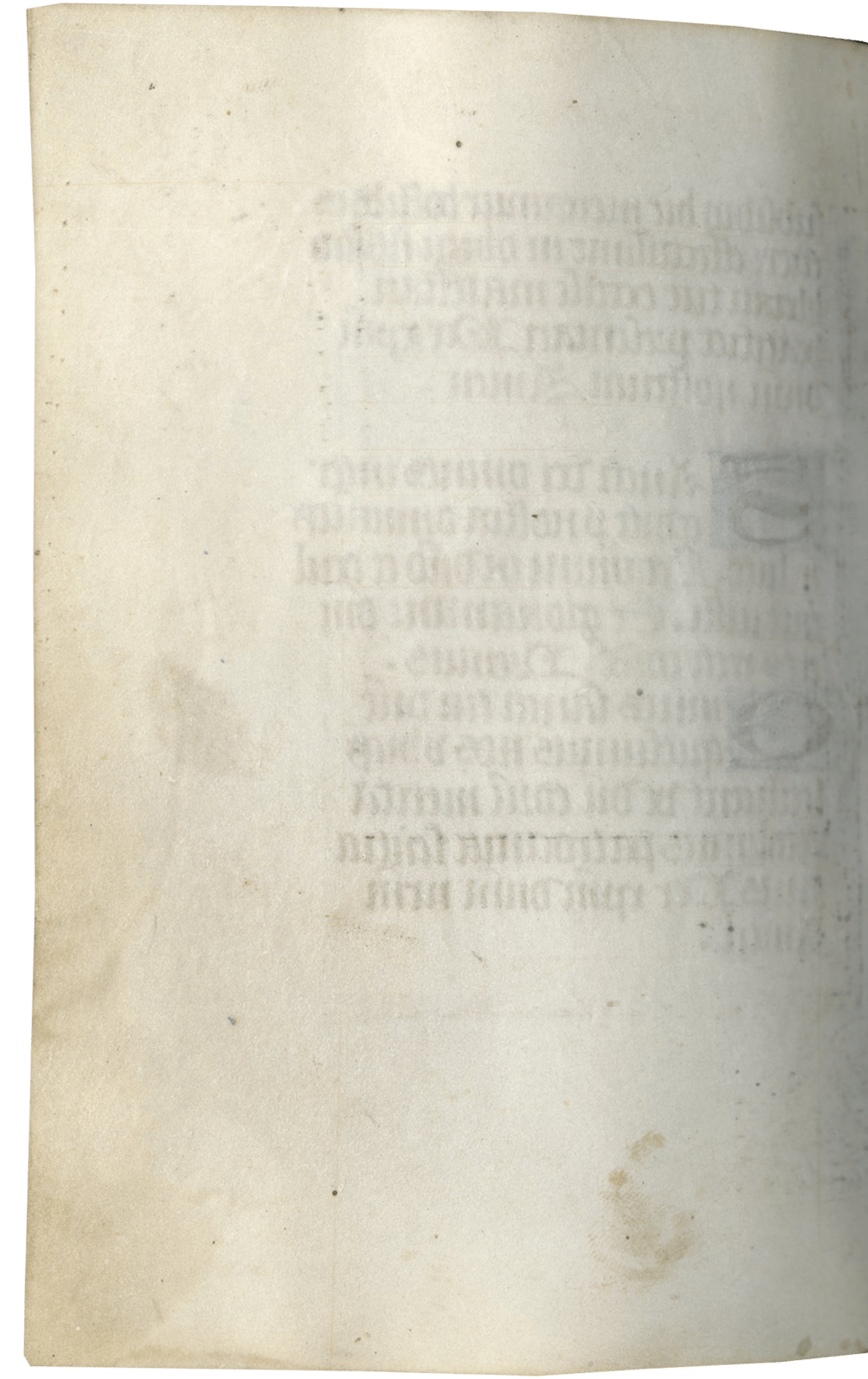
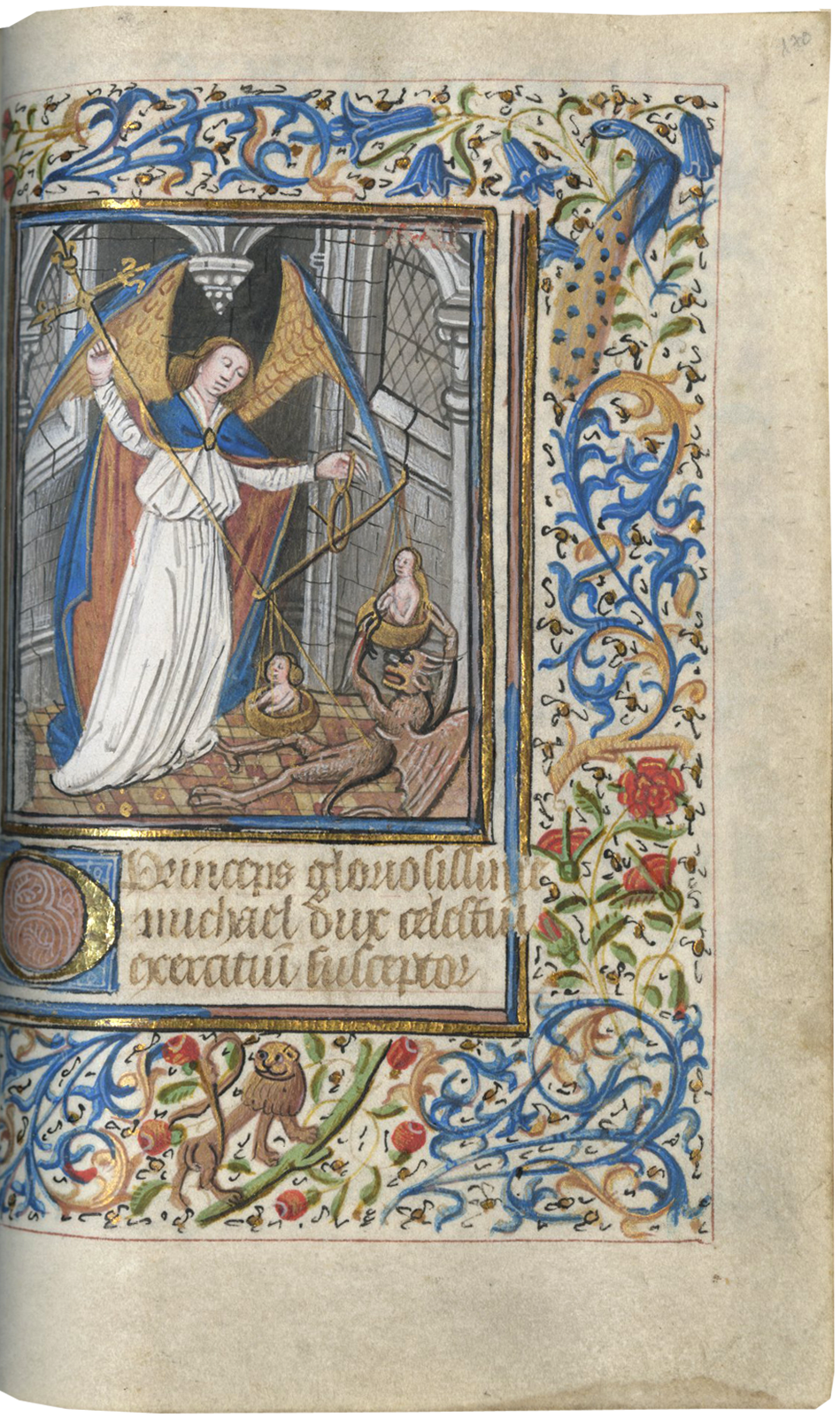



Description
This is a fascinating Book of Hours with an extensive cycle of illuminations by three different artists. It offers an excellent case study of how Books of Hours were customized for the special devotional needs and artistic taste of owners even within a generation of each other. Made of an unknown patron (a woman) around 1460, the original manuscript was updated only about a decade later for Jean Antoine de Mahieu, Lord of Bosqueau, and his wife, Jacqueline de Sivry, Lady of Buath, in Mons. From the best of the three artists, they ordered a lovely miniature with their portraits and arms, announcing their ownership, and paying tribute to a local hero, Simon Marmion.
199 folios on parchment (f. 199 is pasted onto the back cover), modern foliation in pencil, 1-199, lacking one text leaf (collation: i12 ii8 [+1, one inserted miniature, f. 13] iii8 [+1, one inserted miniature, f. 22] iv8 v8 [+2, one inserted miniature, f. 40] vi8 [+4, one inserted miniature, f. 51] vii12[+10, one inserted miniature, f. 67, bound out of place; should be in quire xx] viii6 [+3, one inserted miniature, f. 72] ix8 [+1, +6, two inserted miniatures, ff. 77, 82] x8 [+4, one inserted miniature, f. 90] xi6 [+1, +8, two inserted miniatures, ff. 96, 103] xii-xiii8 xiv8 [+1, one inserted miniature, f. 120] xv8 [-7, lacking one leaf after f. 134] xvi-xviii8 xix4 xx8 [lacking one leaf, f. 67, which is bound out of place in quire vii; the order of the leaves in this quire is also incorrect: f. 170 should precede f. 169] xxi-xxiii8 xxiv5), no catchwords or signatures, ruled in red ink (justification 95 x 61 mm.), written by two different scribes (corresponding to the two artists: scribe B wrote ff. 67r-v, 164-170v; scribe A wrote the rest) in brown ink in gothic textualis bookhand in single column on 17 lines, capitals touched in yellow, line-fillers in pink and blue with decorative details in burnished gold, 1-line initials alternating in burnished gold with penwork flourishes in black and in blue with penwork in red, 2-line initials in burnished gold on grounds divided into dark pink and blue with white penwork, 3-line initials of similar style with hairline tendrils extending to the margin with small flowers and leaves in burnished gold, 5-line burnished gold initials on grounds divided into dark pink and blue with white penwork, 5-line painted initials on gold grounds with painted tendrils, leaves and flowers, FOUR VERY FINE SMALL MINIATURES framed with burnished gold bars, within ¾ rinceaux borders decorated with small flowers in colors and small leaves in burnished gold, TWENTY-TWO FINE FULL-PAGE MINIATURES within full rinceaux borders decorated with flowers, berries, curving acanthus leaves and numerous imaginative hybrids playing musical instruments, highlighted with generous amounts of burnished and liquid gold, in addition sixteen full rinceaux borders and 5-line initials in pink or blue on burnished gold grounds; ink stain in the margin of f. 1, water stains in the lower margins of the first 32 leaves, colors slightly faded in the marginal decoration on f. 120v, a stain in the marginal decoration of f. 77v and some other minor signs of use, otherwise in very good condition. Bound in the seventeenth century in brown calf over wooden boards, spine with four raised bands, gold-tooled with fleurons and foliage, gilt title (“OFFICIU / BEATEM / VIRGIN”, partly worn out), gilt edges, leather very rubbed, gold tooling worn, front cover almost detached, hinges of the back cover fragile. Dimensions 167 x 116 mm.
Provenance
1. The manuscript was made in Southern Netherlands probably in two different stages. The core of the Hours and the calendar were written in Mons for an unknown patron with inserted miniatures by the Mildmay Master of Bruges, c. 1460. The Calendar and the Office of the Dead for the use of St. Waltrude in Mons. Then, around 1480, the manuscript was updated also in Mons by a couple represented in prayer at the feet of the Virgin on f. 119v, Jean Antoine de Mahieu, Lord of Bosqueau, and his wife, Jacqueline de Sivry, Lady of Buath (see the discussion below). The manuscript was illuminated by three different artists at two different stages (see discussion below).
2. The manuscript belonged to Jean-Baptiste-Florentin Gabriel de Meyran, marquis de Lagoy (1764-1829): a small label with the note “appartient au Marquis de Lagoy” attached inside the front cover. He was the nephew and executor of the testament of marquis de Méjanes, whose collection, essentially of Old Master drawings, constituted the founding collections of the municipal library in Aix-en-Provence.
3. Another ownership inscription written in grey ink inside the front cover: “Jean Fra(n)sois de Lescluse demeurant a Frasne”. Frasne is only 37 kilometers from Mons.
Text
ff. 1-12v, Calendar, use of Mons; f. 13, blank;
ff. 13v-21v, Hours of the Cross; f. 22, blank;
ff. 22v-28, Hours of the Holy Spirit;
ff. 28v-34, Mass of the Virgin;
ff. 34v-39v, Gospel Sequences; f. 40, blank;
ff. 40v-95v, Hours of the Virgin, use of Rome;
ff. 97-100v, Obsecro te (for female use, “miche famulae tue”);
ff. 100v-102v, O intemerata; f. 103, blank;
ff. 103v-113, Penitential Psalms;
ff. 113-119, Litanies, followed by prayers; f. 119v, miniature: Jean Antoine de Mahieu and Jacqueline de Sivry before the Virgin and Child; f. 120, blank;
ff. 120v-161, Office of the Dead, use of the Saint Waltrude Collegiate Church in Mons (cf. Ottosen, Online resources);
ff. 161v-163, Prayers for the Mass and when the priest raises the host, f. 163v, blank;
ff. 164-170v, Prayers to St. James the Great (f. 164r-v), St. Hubert of Liège (f. 165r-v), St. Paul (f. 166r-v), St. Francis (f. 167r-v), St. Barbara (f. 168r-v), and St. Michael (ff. 169, 170r-v; leaves bound in wrong order: f. 170 should precede f. 169; f. 169v blank);
ff. 171-199, Prayers on the Seven Last Words from the Cross (ff. 171-172v), Passion Sequences from the Gospel of St. John (ff. 173-174v), Prayers to Christ (ff. 174v-177v), the Holy Trinity (f. 178), St. Michael (f. 178r-v), Holy Angels (ff. 178v-179), St. John the Baptist (f. 179), St. John the Evangelist (f. 180), Holy Apostles (f. 180r-v), St. Christopher (ff. 180v-181v), St. Sebastian (ff. 181v-182), St. George (ff. 183-184), St. Adrien (ff. 182v-183), St. Hubert of Liège (f. 183r-v; different from the prayer on f. 165r-v), St. Anthony (ff. 183v-184), St. Nicholas (f. 184r-v), St. Joseph (ff. 184v-185), St. Mary Magdalene (f. 185r-v), St. Martha (ff. 185v-186), St. Catherine (f. 186r-v), St. Barbara (ff. 186v-187; different from f. 168r-v), St. Agathe (f. 187r-v), St. Agnes (ff. 187v-188), St. Wilgefortis (f. 188r-v, rubric, “de sancta ontcommera”), Virgins (ff. 188v-189), eight verses of St. Bernard (ff. 189-190), St. Margaret (f. 190v), a prayer attached to an indulgence that promises as many days of pardon as there are bodies buried in a cemetery, incipit, “Avete omnes anime fideles...” (ff. 191-192v), and a prayer, which the rubric instructs to be said to the Virgin on Saturdays, incipit, “Missus est gabriel angelus...” (ff. 192v-199).
Illustration
Thirteen full-page miniatures by the Mildmay Master
f. 13v, Descent from the Cross
f. 22v, Pentecost
f. 28v, Virgin and Child surrounded by angels
f. 40v, Annunciation to the Virgin
f. 51v, Visitation
f. 62v, Nativity
f. 72v, Annunciation to the Shepherds
f. 77v, Presentation at the Temple
f. 82v, Herod ordering the Massacre of the Innocents
f. 90v, Flight to Egypt
f. 96v, Pietà, flanked by St. John and St. Mary Magdalene
f. 103v, Last Judgment with the Virgin and St. John
f. 120v, Funeral office, a nobleman standing by the coffin with his prayerbook first patron
Two full-page miniatures by a second, later artist, a follower of Simon Marmion in the second campaign:
f. 119v, Jean Antoine de Mahieu and Jacqueline de Sivry before the Virgin and Child
f. 161v, Mass of St. Gregory, a male supplicant kneeling in the background
Seven full-page miniatures by the Master of Philippe de Croÿ:
f. 67, Holy Virgins (bound out of place)
f. 164, St. James the Great as pilgrim
f. 165, St. Hubert in prayer before a deer
f. 166, St. Paul
f. 167, St. Francis receiving the stigmata
f. 168, St. Barbara, with a female supplicant kneeling at her feet
f. 171, St. Michael weighing souls
Four small miniatures by artist A, the Mildmay Master:
f. 34v, St. John on Patmos
f. 35v, St. Luke with ox
f. 37, St. Matthew with angel
f. 38v, St. Mark with lion
This is a very interesting book, in which we find contributions by three distinct artists, and it illustrates unusually well how deluxe Books of Hours were customized within even a generation of their original composition to conform with the artistic tastes and devotional culture of new owners.
The original manuscript ended at f. 161 and includes ff. 171 to 192 (with the unillustrated Suffrages beginning on f. 178). It was complete in itself with all the textual components of a typical Book of Hours, as well as a full cycle of thirteen full-page and four smaller miniatures. The full-page miniatures are all on inserted singletons. Three miniatures now nestled in the core of the manuscript do not belong with it, and they were added in the second campaign, f. 67, f. 119v, and f. 161v (see below).
It is the Mildmay Master who was responsible for the core of the original manuscript. This artist specialized in Books of Hours for the continental and English market. Nicholas Rogers gave the artist his name in 1982 after a lavish Book of Hours, also produced for the export market, which includes notes of the family of “Sir Thomas Myldmaye, knight” whose relatives were later connected with the court of Elizabeth I (Chicago, Newberry Library, MS Case 35; also Saenger 1989) (fig. 8a, 8b) The Mildmay Master worked in the style of his contemporary Willem Vrelant of Bruges (arrived in Bruges in 1454; died 1480/1481), who, while maintaining a workshop, may also have functioned as a sort of libraire or stationer, assembling artists, scribes, decorators, and binders for diverse commissions. The deep reds and blues and the wide palette of greens are all typical of Vrelant and his associates and followers, and many of the compositions repeat Vrelant’s well-known patterns.
Extraordinarily productive and perhaps a “style” rather than a single hand, the Mildmay Master favored figures with markedly blushed cheeks and women and young men with slightly pointed chins. His intimate illuminations evoke Bruges painting of the day, especially those of Hans Memling, for example the Annunciation (f. 40v) and the standing Virgin and Child with Angels (f. 28v) 9). In our manuscript, the artist paints elongated figures, with small heads and slender bodies, mostly situated on pale yellow tiled grounds. His outdoor landscapes are cursory, and he favors the same tone of light yellow for paths and bare grounds. Unusual here are his delicate acanthus and floral borders sprinkled with fanciful grotesques.
Our manuscript joins an ever-growing group of manuscripts in the Vrelant circle, which has become a kind of “catch-all” for manuscript illumination in Bruges in the third quarter of the fifteenth century (see exhibition Brussels and Paris, 2011, p. 242). In 2011, Bousmanne and Delcourt proposed an alternative to the complex commercial operation; they hypothesized the existence of a small family structure, in which anonymous hands, such as the Master of the Vraie Cronicque descose, were members of Vrelant’s family. Vrelant’s widow Marie (the Master of the Vraie Cronicque descose?), for example, continued to pay dues to the guild in Bruges until 1490-1491. The place of the Mildmay Master (or Masters) – whether a member of the family or part of a commercial network – with his/ her appealing colorful style in this “Vrelant” group has yet to be sorted out satisfactorily.
The patron of the original manuscript is unknown. There is a nobleman standing apart in the Funeral miniature prefacing the Office of the Dead, but we believe the book was instead made for a woman because the prayer Obsecro te is for female use. Although the paintings were made in Bruges, the text of the manuscript was made in Mons. The Office of the Dead follows the liturgical use of the Saint Waltrude Collegiate Church in Mons. The calendar also follows the use of Mons, including the rare St. Ghislain of Mons in red (9 Oct). The city of Mons belonged to the diocese of Cambrai, and the calendar includes a number of saints venerated in this diocese, as well as the neighboring dioceses of Tournai and Liège. The rare St. Ursmar of Lobbes (18 Apr) was venerated in the dioceses of Cambrai and Liège, and St. Achard (or Achaire) of Jumièges (15 Sept) also in the diocese of Tournai (cf. Leroquais 1927, nos. 125, 323; Calendoscope, Online resources). Other locally venerated saints in the calendar include: St. Bavo of Ghent (1 Oct), St. Aldegonde of Maubeuge (30 Jan), St. Brigit (1 Feb), St. Amand of Maastricht and Vedast (Vaast) of Arras (7 Feb), St. Scholastica (10 Feb), St. Juliana of Nicomedia (16 Feb), St. Gertrude (17 March), St. Donatian of Reims (14 Oct), and St. Walaric or Valery (1 Apr). For a comparison of a contemporary Book of Hours following the liturgical use of Saint Waltrude of Mons, see Amiens, Biblithèque municipale, MS 206 (see Online resources).
The prayer to the rare St. Wilgefortis, a bearded crucified woman, under the Flemish name “Ontkommer” (f. 188r-v, rather than “Livrade” in French) could mislead one to think that this manuscript was destined for the Flemish rather than French-speaking part of the Southern Netherlands. However, the numerous rubrics in French confirm that the manuscript was made for francophone patrons (for example on f. 191). The paintings, on singletons, were thus sent from Bruges to Mons for insertion. On stylistic grounds they cannot date much after 1460.
Shortly thereafter (perhaps on the death of the first owner – a member of the same family in Mons?), the manuscript was altered to reflect new ownership, that of Jean Antoine de Mahieu, Lord of Bosqueau, and his wife, Jacqueline de Sivry, Lady of Buath, represented on f. 119v. This inserted miniature is clearly out of place in this, the original, section of the manuscript. Their coats of arms are presented above them, held by angels. On the left, the arms of de Mahieu: d’argent à deux quintefeuilles de gueules en chef et une merlette de sable en pointe. On the right, the arms of Jacqueline de Sivry: parti, au 1 d’argent à deux quintefeuilles de gueules en chef et une merlette de sable en pointe (de Mahieu); au 2 écartelé: aux 1 et 4 burelé d’argent et d’azur (de Sivry); au 2 et 3 d’or à deux chevrons de gueules (de Montigny). Jean Antoine de Mahieu, écuyer, Lord of Bosqueau, was born c. 1460, the younger son of Henri de Mahieu, chevalier, and Isabeau de Landas, who had married in 1447 and lived in Maubeuge, south of Mons, in the diocese of Cambrai, where they held several feudal lands (Delcourt 1865, p. 449). The de Mahieu was an ancient noble family that originated in Guelders in the twelfth century; later generations spread to Mons, Valenciennes, Cambrai, Maubeuge, Antwerp, Ghent and Brussels (Delcourt 1865, p. 439-440). The branch of the family to which the owner of our manuscript, Jean Antoine de Mahieu belonged, was installed around Mons and Maubeuge in the diocese of Cambrai. Several members of the family had been ennobled with titles of chevalier and écuyer (Delcourt 1865, pp. 449-450). Jean Antoine de Mahieu married Jacqueline de Sivry, Lady of Buath. They had a daughter, Jacqueline de Mahieu, Lady of Bosqueau, who married Eustache de Masnuy, échevin of Mons (Rietstap 1861, pp. 130, 784; Delcourt 1865, pp. 449-450).
The artist responsible for updating the manuscript, adding seven miniatures to accompany Suffrages, and for f. 67, now out of place but originally within the Suffrages, is the Philippe de Croÿ Master, whom Dominique Vanwijnsberghe named after his principal patron, seigneur de Croÿ et comte de Porcéan (1435-1511) (“Ung bon ouvrier nommé Marquet Caussin,” Brussels: KIKIRPA, 2013, pp. 78-79, 250-56, et passim). His style is completely different from the Mildmay Master. He favors tiled floors in brown and white or grey and white, and his palette is generally more sombre, almost grisaille, with blue and white, grey, and a burnt brownish-orange. Having miniatures accompany these prayers must have been important to the new owners Jean and Jacqueline, because the many of the same prayers (Hubert, Barbara, for example) occur, though unillustrated, in the original portion of the manuscript. This illuminator is active in the 1480s (see the Hours illuminated by him in Brussels, Bibliotheque Royale, MS 15080).
A third painter intervened at the same time in this second campaign. The most skilled of the three illuminators, this artist (responsible for ff. 119v and161v) is a follower of a group of Hainaut (Valenciennes or Mons) illuminators working around 1480-1500 published by Gregory Clark in 2004 (see especially figs. 1, 2, 6, 8, and 10 there, from a Book of Hours in Stuttgart). His delicate figures are well-modeled, with tiny hands, and individualized faces. His tributes to Simon Marmion are visible in the two angels that hold shields on f. 119 with their sweet faces, and the couleurs changeant of their wings and drapery. Like the Mildmay Master he uses yellow tiled floors but the tiles are distinctly different, giving a three-dimensional effect. The Mass of St. Gregory is a tour de force by this artist, and here again there is a tribute to Marmion in the coloring, facial types, and even the composition.
We are grateful to Gregory Clark for his assistance.
Literature
As-Vijvers, A. and A. Korteweg, (eds). Splendour of the Burgundian Netherlands, Utrecht, Zwolle, The Hague, 2018, pp. 304-5, 374.
Bousmanne, B. and T. Delcourt (eds). Miniatures flamandes, 1404-1482, Paris and Brussels, 2011.
Clark, G. “Beyond Jacquemart Pilavaine, Simon Marmion, and the Master of Antoine Rolin: Boo Painting in the Hainaut in the Penultimate Decade of the Fifteenth Century,” pp. 391-98 in Brigitte Dekeyzer and Jan Van der Stock, eds., Manuscripts in Transition—Recycling Manuscripts, Texts, and Images: Proceedings of the International Congress Held in Brussels (5-9 November 2002), Louvain, 2005.
Delcourt, F. J. “Généalogie de la famille de Mahieu,” Annales de l’Académie royale d’archéologie de Belgique 21 (1865), pp. 439-490.
Kren, T. and S. McKendrick. Illuminating the Renaissance: The Triumph of Flemish Manuscript Painting in Europe, Los Angeles and London, 2003.
Leroquais, V. Les livres d’heures manuscrits de la Bibliothèque nationale, 3 vols, Paris, 1927.
Ottosen, K. The Responsories and Versicles of the Latin Office of the Dead, Aarhus, 1993.
Rietstap, J.-B. Armorial général d’Europe, Gouda, 1861.
Smeyers, M. and J. Van der Stock, Flemish Illuminated Manuscripts 1475-1550, Ghent, 1996.
Van Wijnsberghe, D. “Ung bon ouvrier nommé Marquet Caussin,” Brussels, 2013 ;
Online Resources
Amiens, Biblithèque municipale, MS 206: http://initiale.irht.cnrs.fr/codex/5963/512
Calendoscope (IRHT, Paris): http://calendoscope.irht.cnrs.fr/application/positif?idSaint=945
K. Ottosen, “Responsories of the Latin Office of the Dead”: https://www.cantusplanus.de/databases/Ottosen/search.html
Virtual exhibition “Miniatures flamandes, 1404-1482” (BNF, KBR, 2011): http://expositions.bnf.fr/flamands/index.htm
